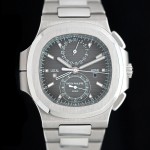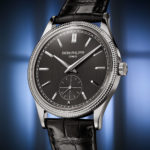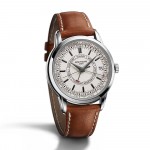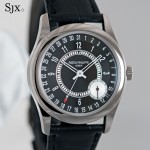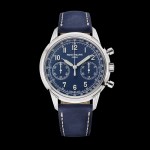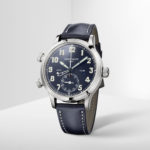In-Depth: Patek Philippe Calatrava Ref. 6119 “Clous de Paris”
A most excellent time-only watch.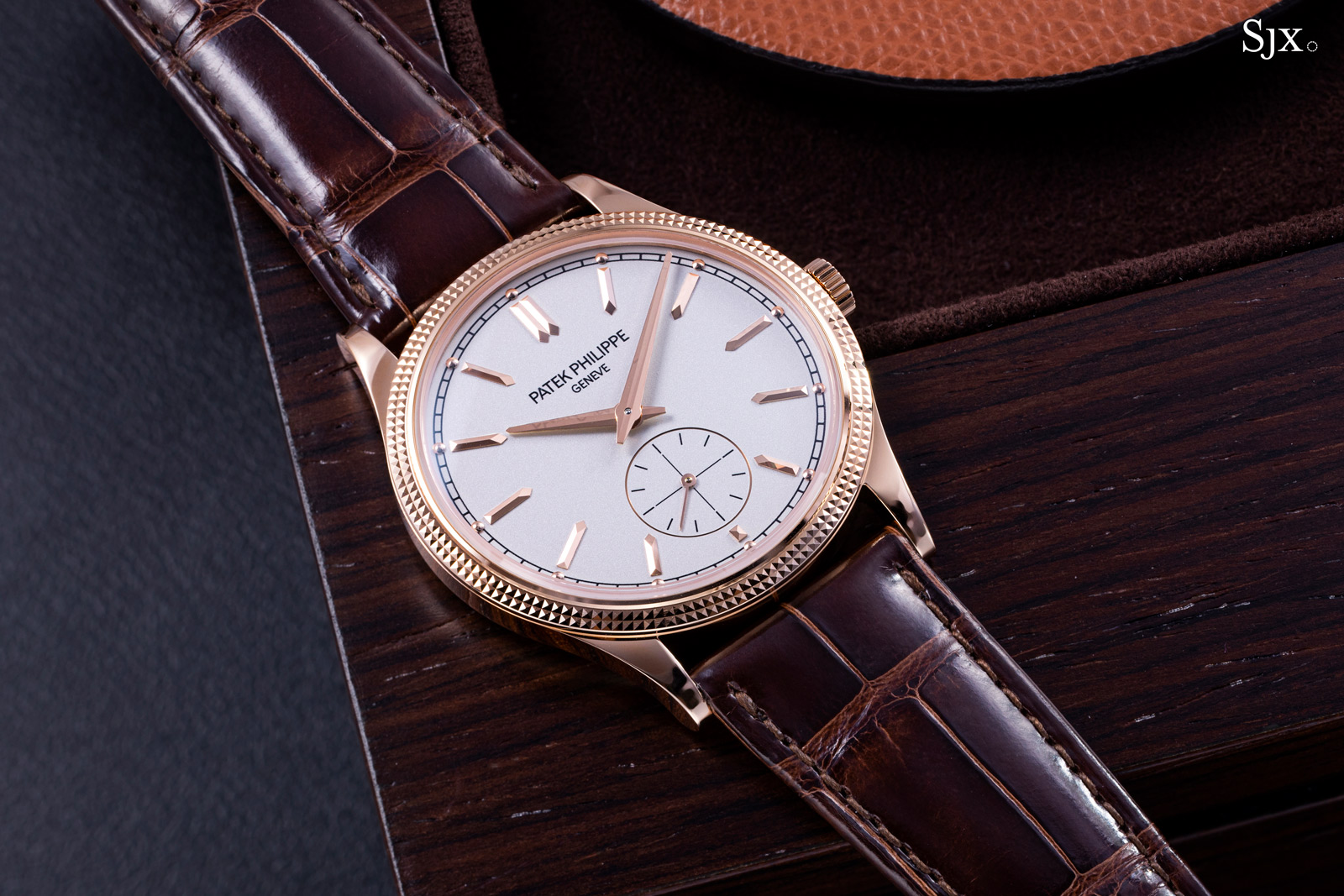
Launched earlier this year, the Calatrava Ref. 6119 “Clous de Paris” is significant amongst Patek Philippe’s recent releases, despite being a simple, time-only watch. That’s because it’s powered by the all-new cal. 30-255 PS, a large, thin movement that is the new workhorse calibre for the brand’s entry-level, hand-wind watches.
Visually, the ref. 6119 takes its cues from past Calatrava models, but the overall design is contemporary and elevated by details like the facetted hour markers and textured dial. But the crucial feature of the ref. 6119 remains the new movement inside.
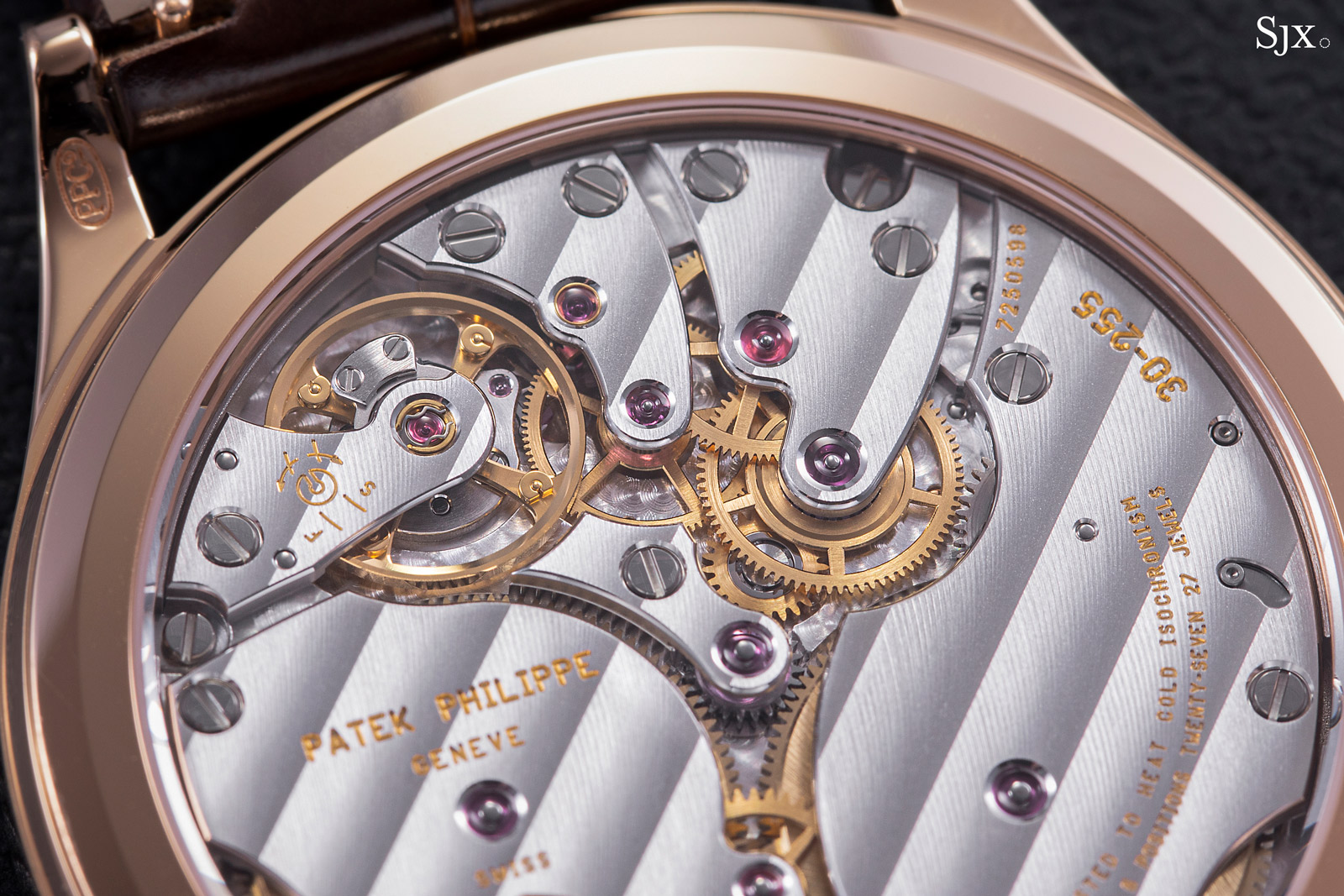
The cal. 30-255, with its large, twin barrels and Gyromax balance
The historical context
Named after the Patek Philippe emblem, the Calatrava was introduced in 1932, the same year the Stern family took over the watchmaker as it struggled amidst the Great Depression.
The original Calatrava was the ref. 96, a handsome but minuscule watch just 31 mm in diameter. While the Calatrava family has multiplied and grown in diversity since its launch, the ref. 96 remains the definitive Calatrava design. Its widely-spaced lugs, baton markers, and dauphine hands are instantly recognisable together, despite being relatively generic in themselves.
In fact, the ref. 96 was influential in defining Patek Philippe’s house style for decades; the ref. 130, for instance, was essentially a ref. 96 with a chronograph.
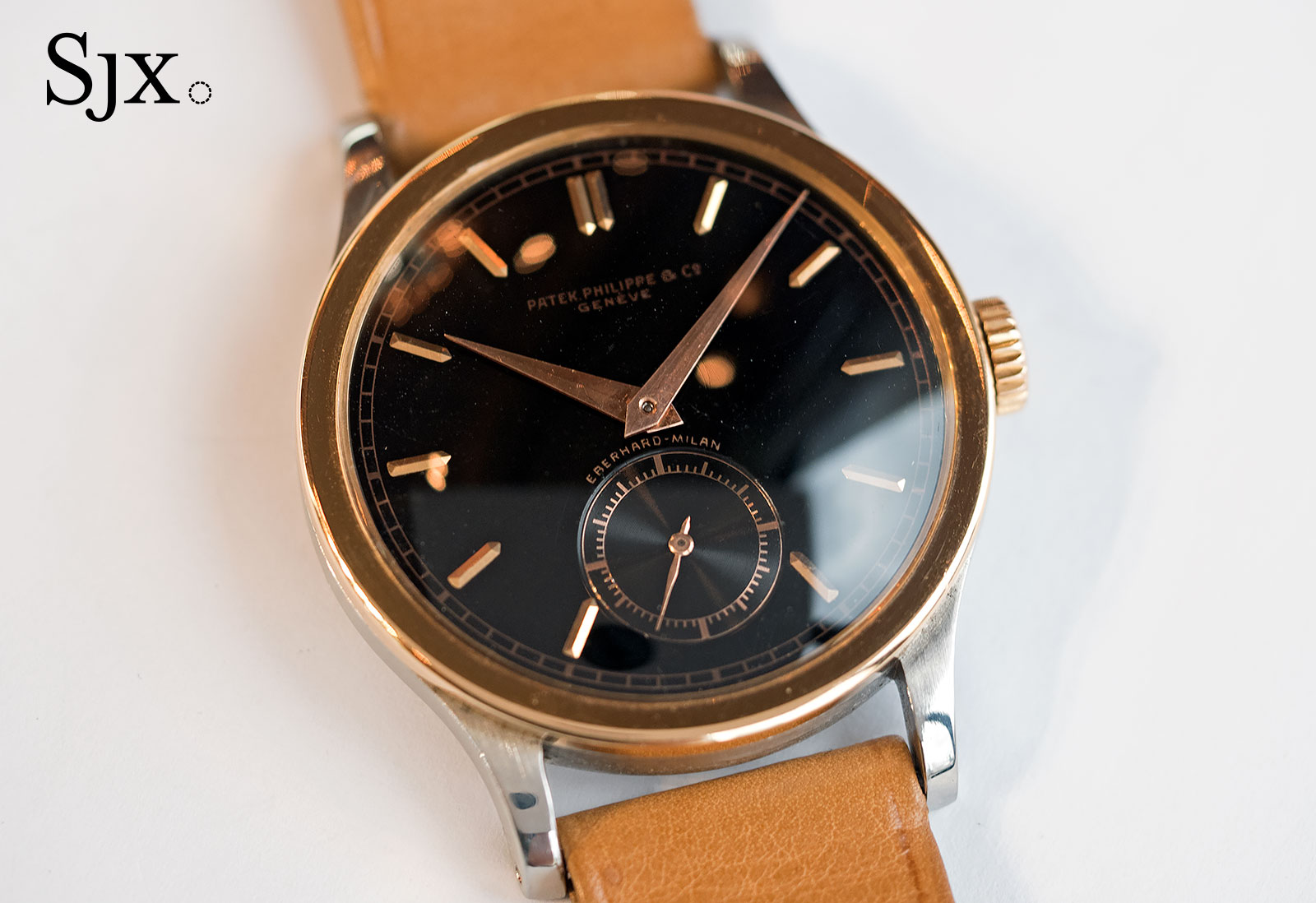
A ref. 570 from 1943, essentially an enlarged ref. 96
One of the longest-lived references in the Patek Philippe catalogue, the ref. 96 continued on until 1982 when it was succeeded by the ref. 3792, which was essentially the same thing with an improved case and movement. And the design subsequently continued on, with successive models preserving the design. The ref. 5196 of today is largely the same design but in a much larger case.
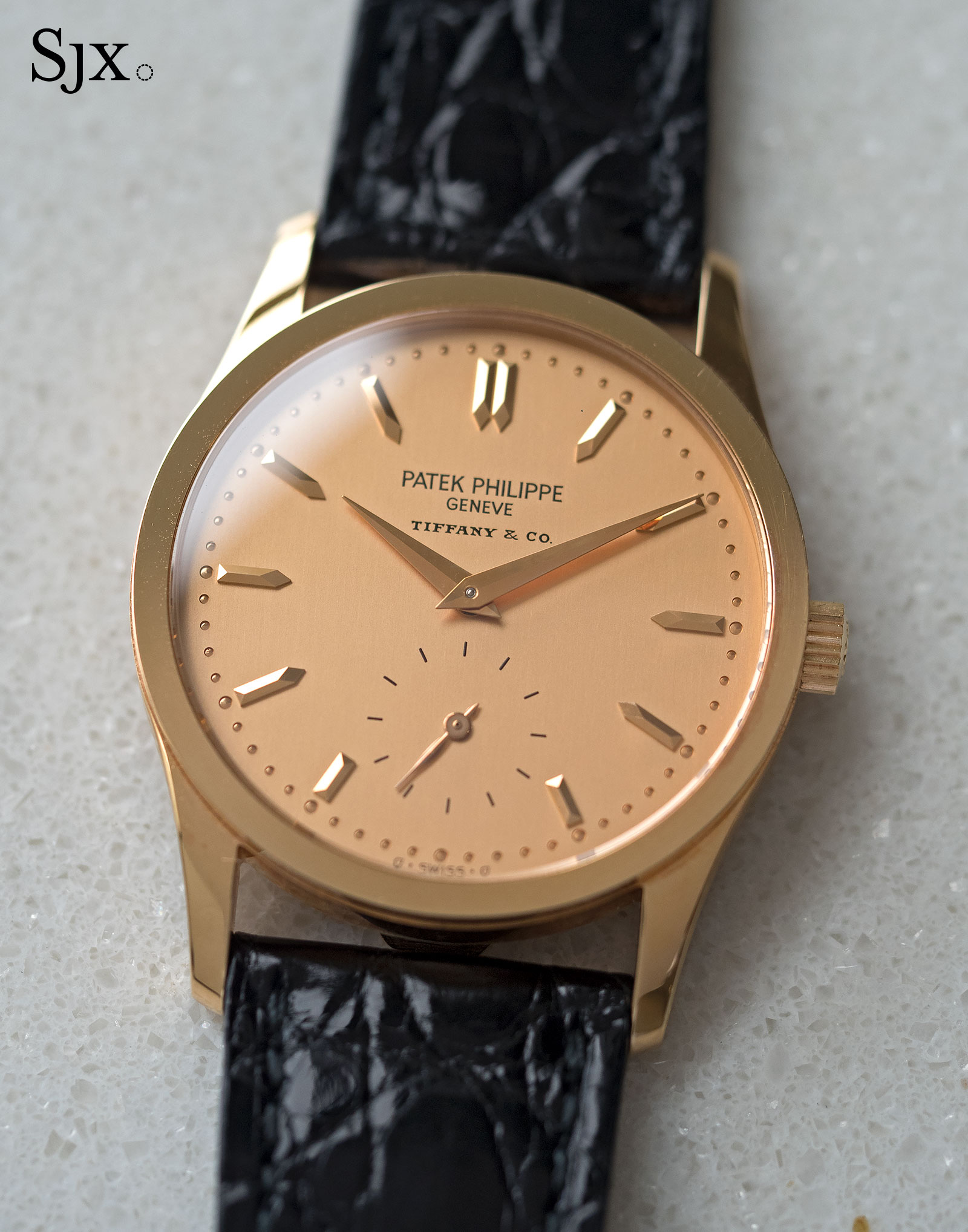
A ref. 3796R from the 1990s, unchanged stylistically from the ref. 96 of 1932
But Patek Philippe has been gradually modernising the Calatrava line – the ref. 5000 of 1992 is an early example – a process that has accelerated in recent years. Mr Stern has commented both publicly and privately that the Calatrava line is due for a revamp to bring it in line with modern tastes and lifestyles.
As a result, the Calatrava lineup has shrunk drastically. At the time of writing, the Calatrava catalogue on the Patek Philippe website only has three references for men (setting aside the jewelled or Rare Handcrafts models): the refs. 5196, 5227, and 6119. Add in the Calatrava models that are in the “Complications” section – the refs. 5212 and 5524 – and the total is just five.
Notably, three of those five – the refs. 5196, 5524, and 6119 – and are clearly descended from the ref. 96 in terms of case design. And the ref. 5196, as the reference implies, is a scaled-up ref. 96.
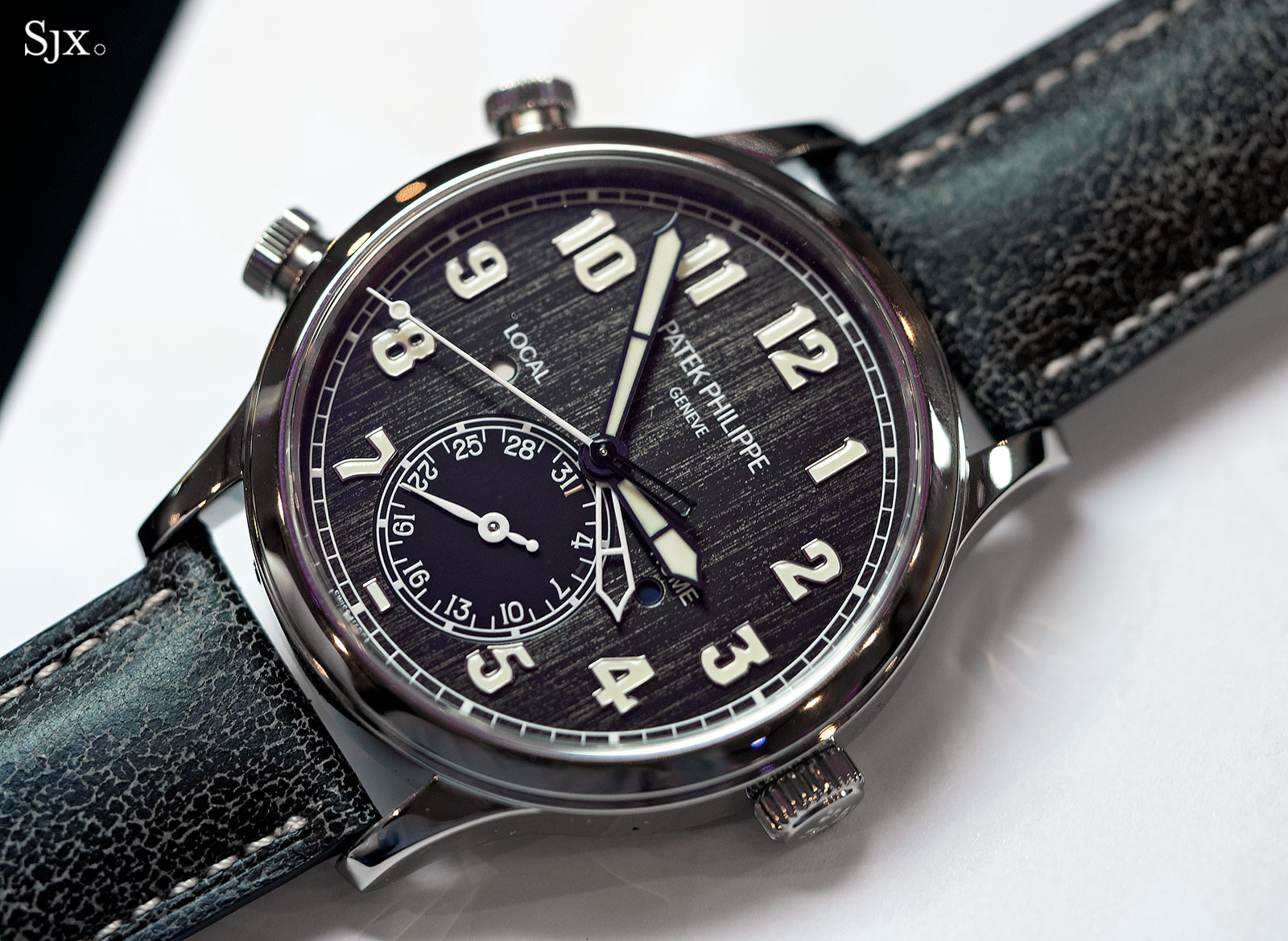
The ref. 5524T in titanium, a unique version of the Calatrava Pilot Travel Time
This is no doubt the low in terms of Calatrava references. Patek Philippe is evidently rebuilding the collection. One consequence of that is the rise of the “casual” Calatrava.
Whereas the model was historically a formal-dress watch, the newer Calatrava models are sporty-ish, with designs that work well as everyday watches, even with casual wear. One of the earliest examples of this was the Calatrava Pilot Travel Time ref. 5524G – a revelation when it was launched in 2015 because it departed so radically from the traditional Calatrava style.
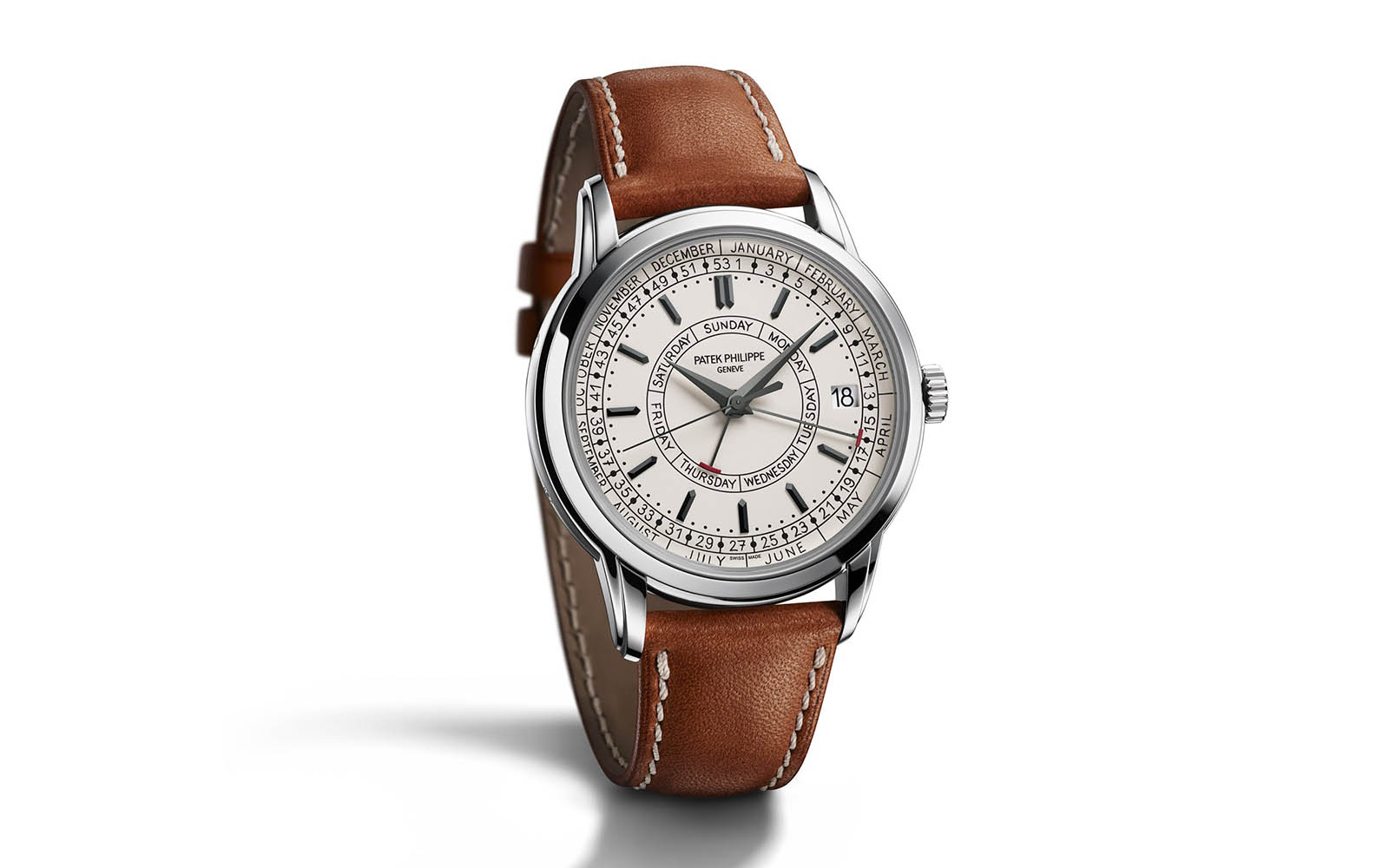
The ref. 5212A with a full calendar that induces the week of the year
The best recent example of trend is the Weekly Calendar ref. 5212A, a quirky, steel watch with all the markings on the dial rendered in a font that reproduces its designer’s handwriting.
Another example is the ref. 6007A made to mark the 2019 opening of the brand’s massive new facility in Plans-les-Ouates.
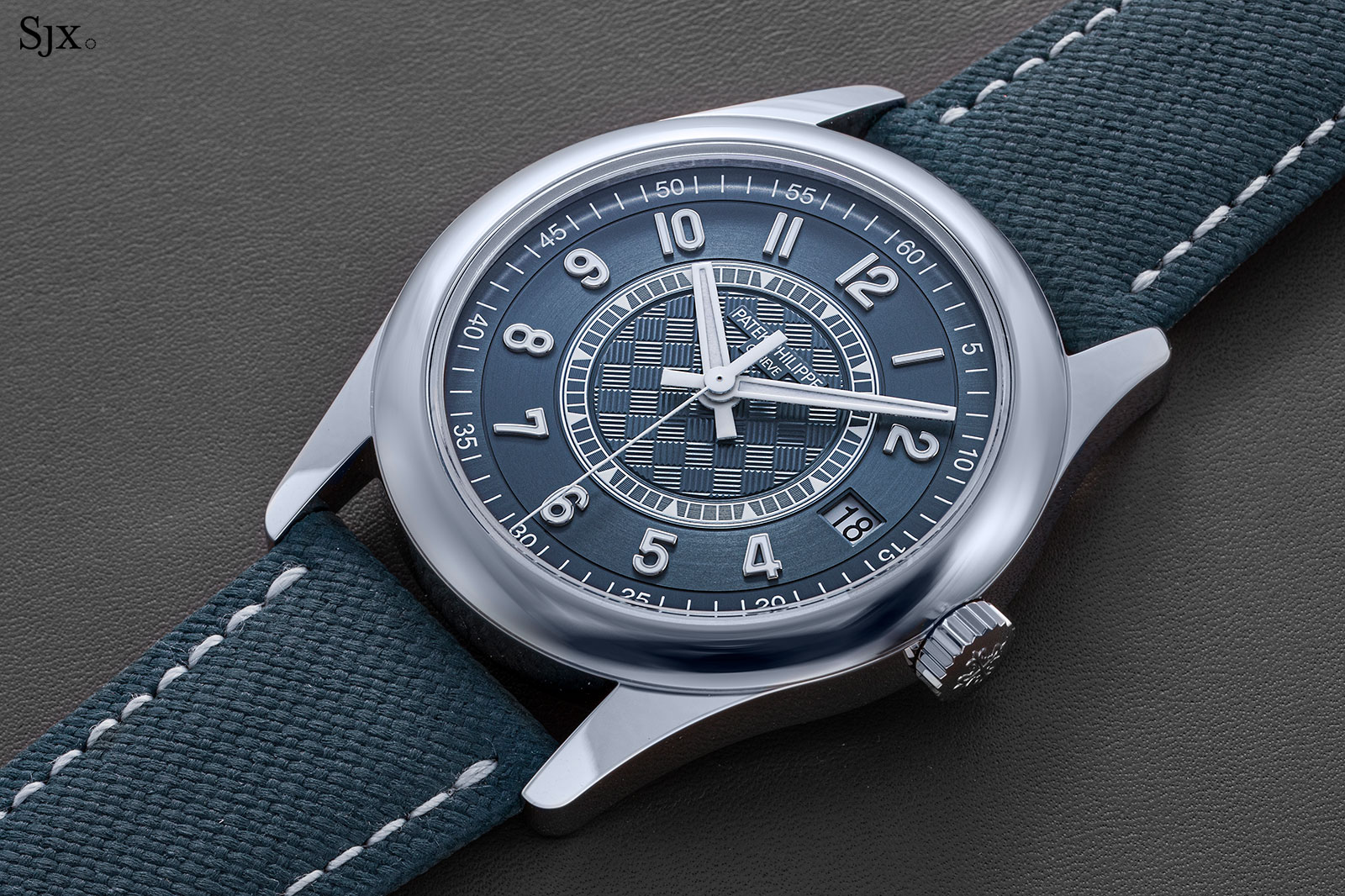
The ref. 6007A with its basketweave guilloche dial
The new ref. 6119 similarly encapsulates the new spirit of the Calatrava line, albeit in a subtly different manner. Unlike the refs. 5212A or 6007A that are both steel – and for that reason, more “casual” – the ref. 6119 has a gold case.
As a result, it is a traditional dress watch in terms of material. And it is also traditional in design, in that it incorporates familiar elements from past Calatrava models. But the ref. 6119 is smartly designed such that it is obviously modern – a ref. 96 remake it is not.
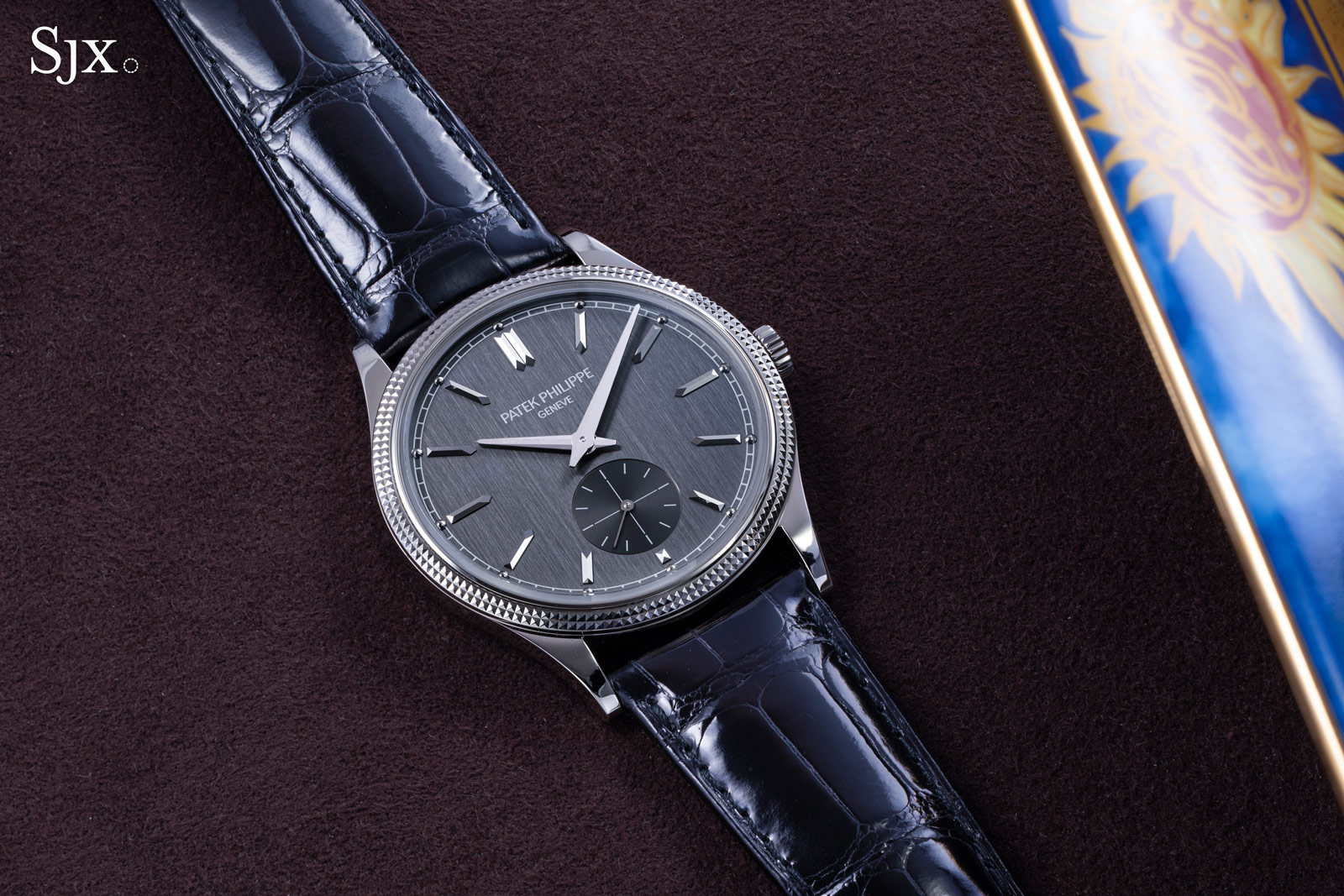
The newest addition to the family, the ref. 6119G
Initial thoughts
As with many of Patek Philippe’s newer models, the ref. 6119 has an evidently modern aesthetic, albeit one that leans on classical designs, most notably of the ref. 3119, the signature Calatrava of the 1980s and 1990s.
At 39 mm the ref. 6119 is one of the largest Calatravas ever, but it’s moderately sized by modern standards. Like most Patek Philippe watches, however, it is slim at a bit over 8 mm high. So it feels refined and elegant on the wrist – and highly reflective due to the case finish – like most Patek Philippe watches.
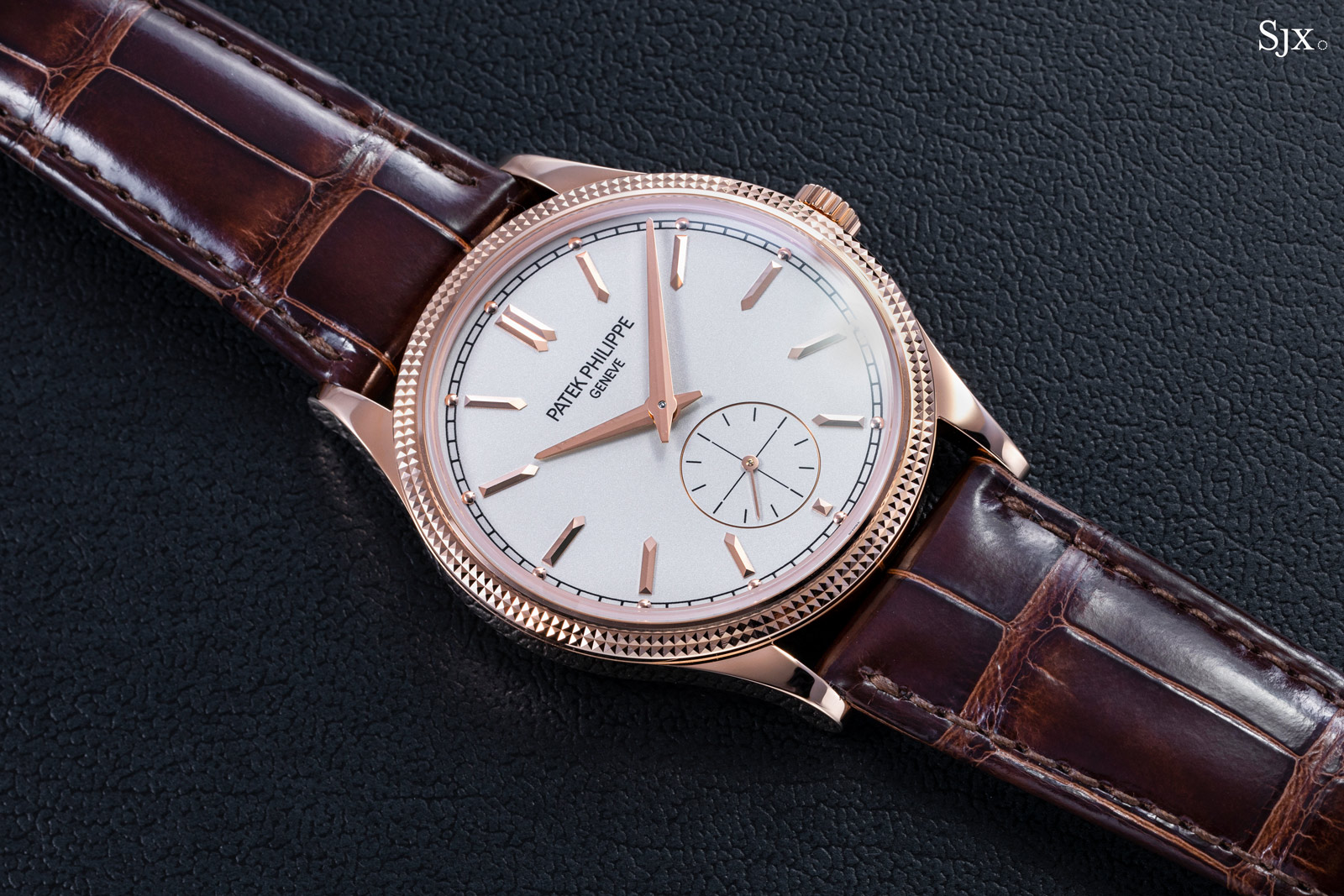
The simplicity of the watch makes it even more obvious how Patek Philippe has upped its game in terms of dial quality. Even compared to recent Calatravas, the ref. 6119 stands out for its double markers, for the hours as well as minutes, as well as the complex form of the hands (though I’m not a fan of the hands, which I find overly elaborate).
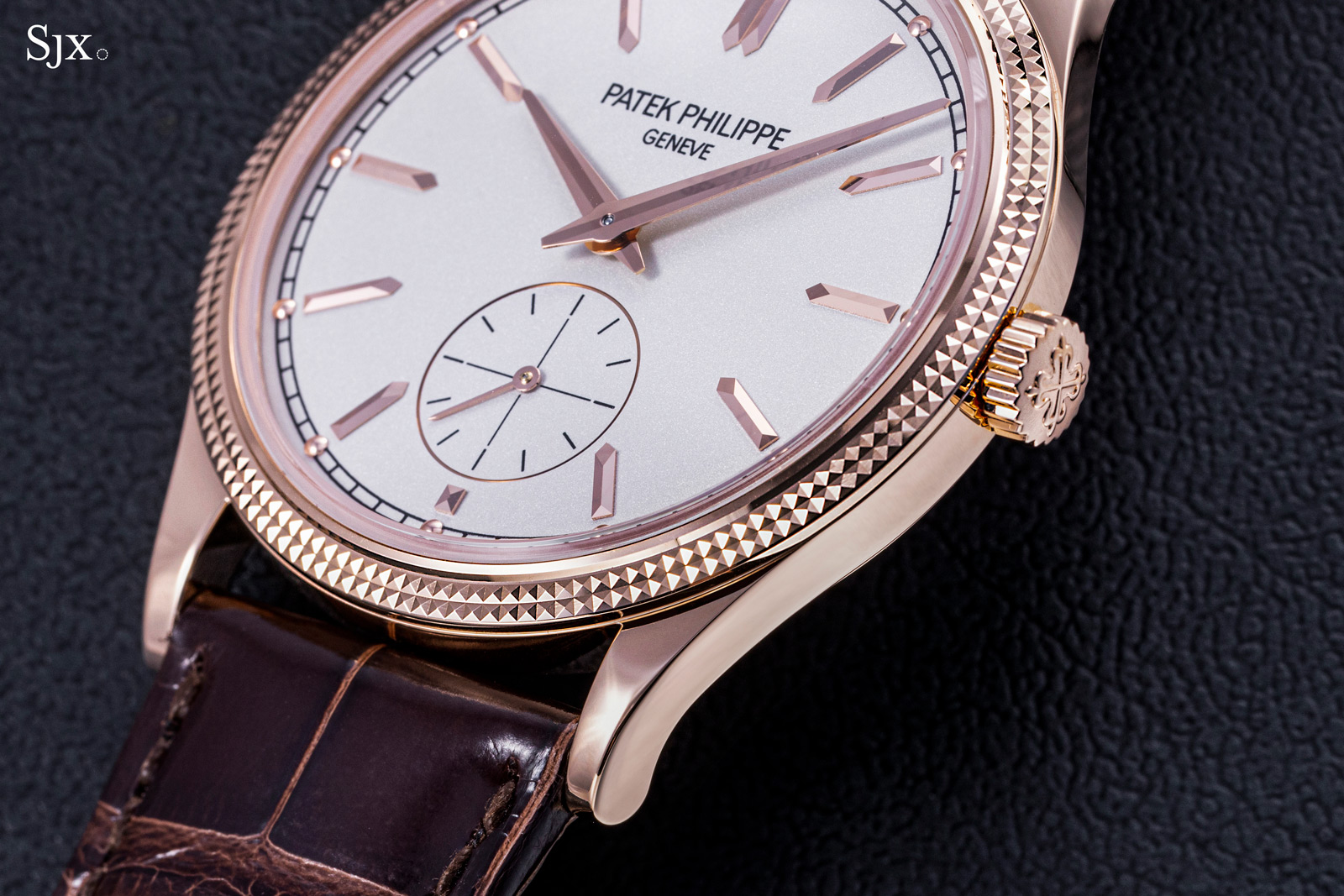
There are two versions of the ref. 6119 currently available, both identical in design but quite different in spirit. Choosing between the two depends on what you’re looking for.
The rose gold version is clearly more classical, looking very much like an old-school dress watch. The white gold model is distinctively more modern, while still being elegant.
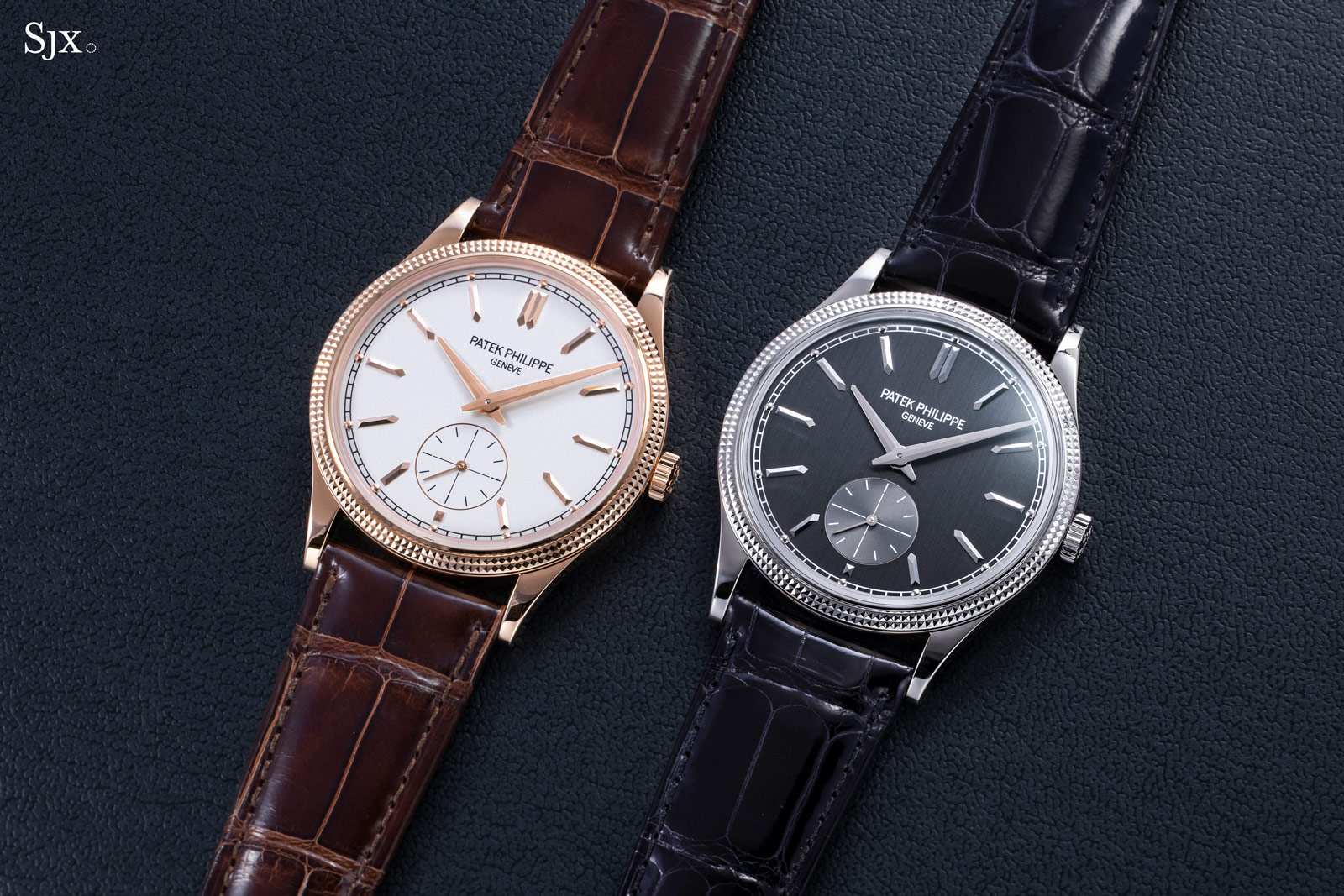
Both iterations of the ref. 6119 cost the same, a but under US$30,000. That’s about 20% more expensive than the ref. 5196, long the base-model Calatrava powered by the cal. 215 (which will surely be replaced by the new cal. 30-255 PS).
Even though the ref. 6119 is pricier, it is better value because it is tangibly better executed. The movement is superior to its predecessor calibre (and also compared to the competition), as is the dial.
The price does mean the ref. 6119 costs more than the equivalent watches from Vacheron Constantin or Breguet, but that’s in keeping with Patek Philippe’s approach to pricing; it is, after all, the high-end watchmaker in Switzerland.
In short, the ref. 6119 is an entry-level Patek Philippe but one that is intrinsically excellent in technical terms, which illustrates that the watchmaker is not merely relying on its brand.
Case design
Though the ref. 6119 is the successor of the ref. 5119 (itself an enlarged version of the ref. 3919), the ref. 6119 is decidedly more modern. The case is essentially two parts, the ref 96 middle and hobnail bezel, which have not combined before (except for a limited edition). Though it blends multiple elements from past models, it still manages to be an original design.
Similar to that found on the refs. 5196 and 5296, the case middle is descended from the original ref. 96, making it perhaps the quintessential Calatrava case. It has longish, tapered lugs set widely apart, and a simple, polished finish.
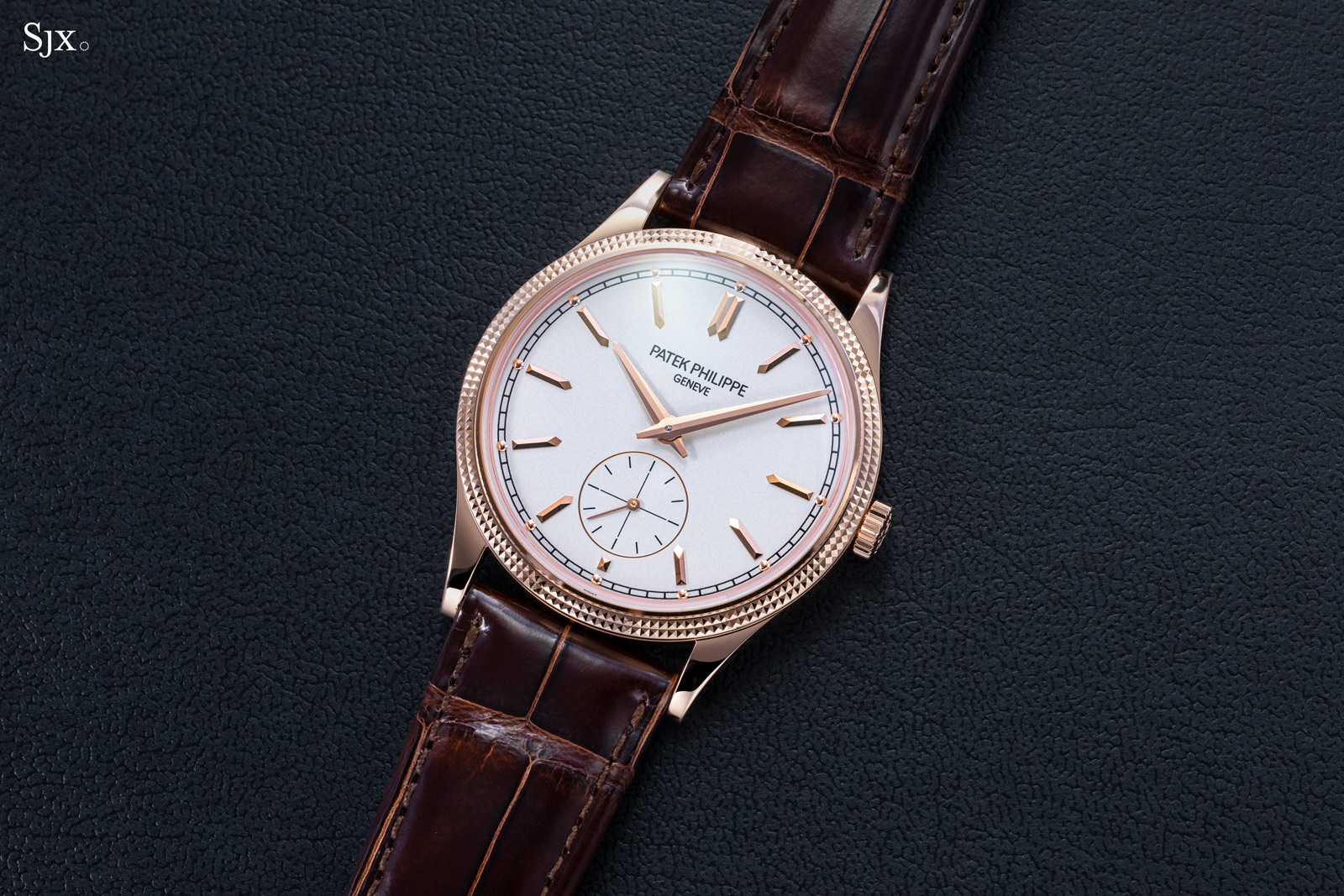
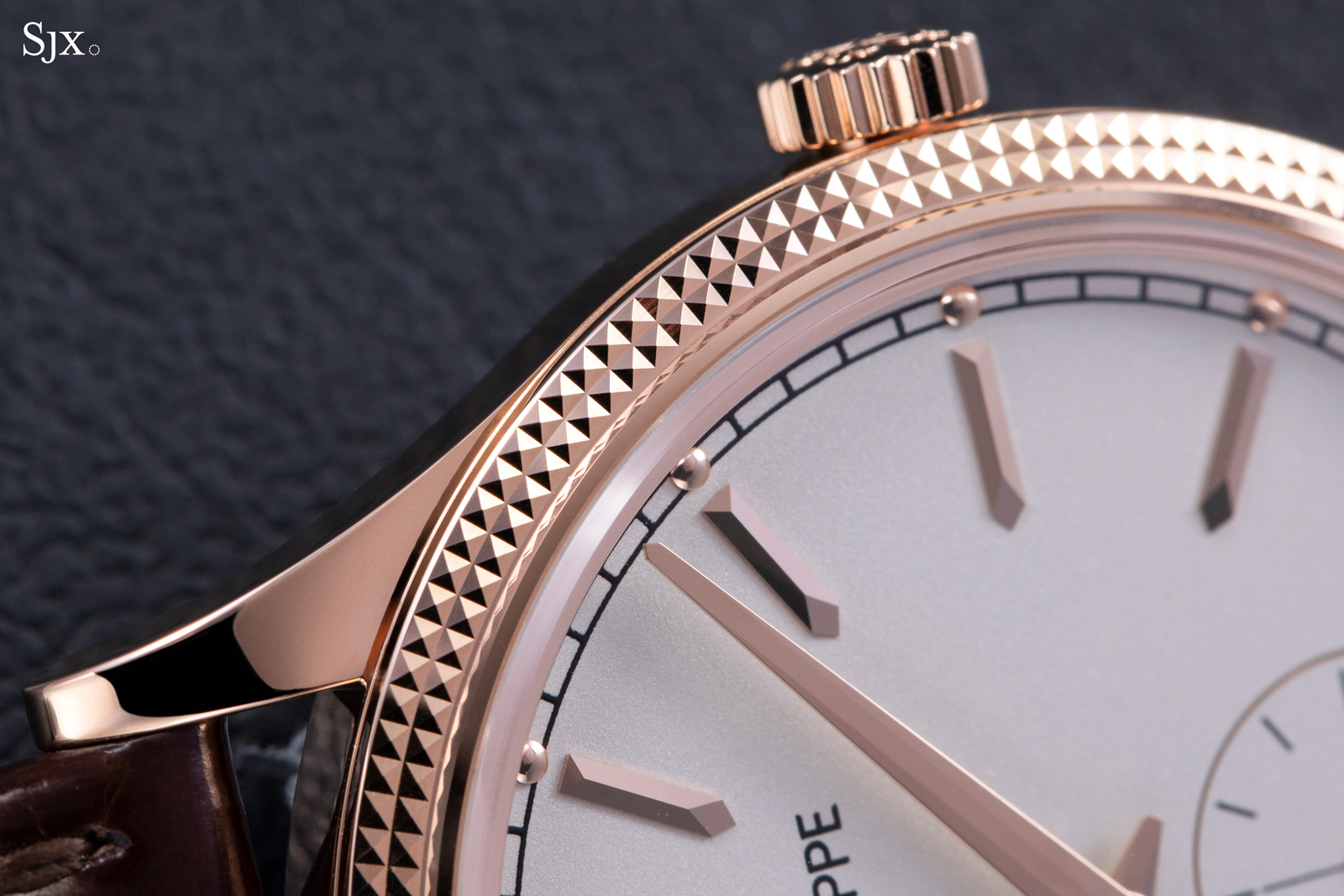
What sets it apart is the clous de Paris bezel, which has a double row of hobnails that give it texture and reflectivity. Historically the hobnail bezel was mostly found on models with straight lugs, like the refs. 3919 and 5119.
That said, the ref. 6119 case isn’t entirely new. It is actually identical to that of the ref. 5399 of 2010, the limited-edition annual calendar – 25 pieces each in rose and white gold – that was created to mark the fifth anniversary of Patek Philippe’s presence in China as well as the opening of its Shanghai boutique.
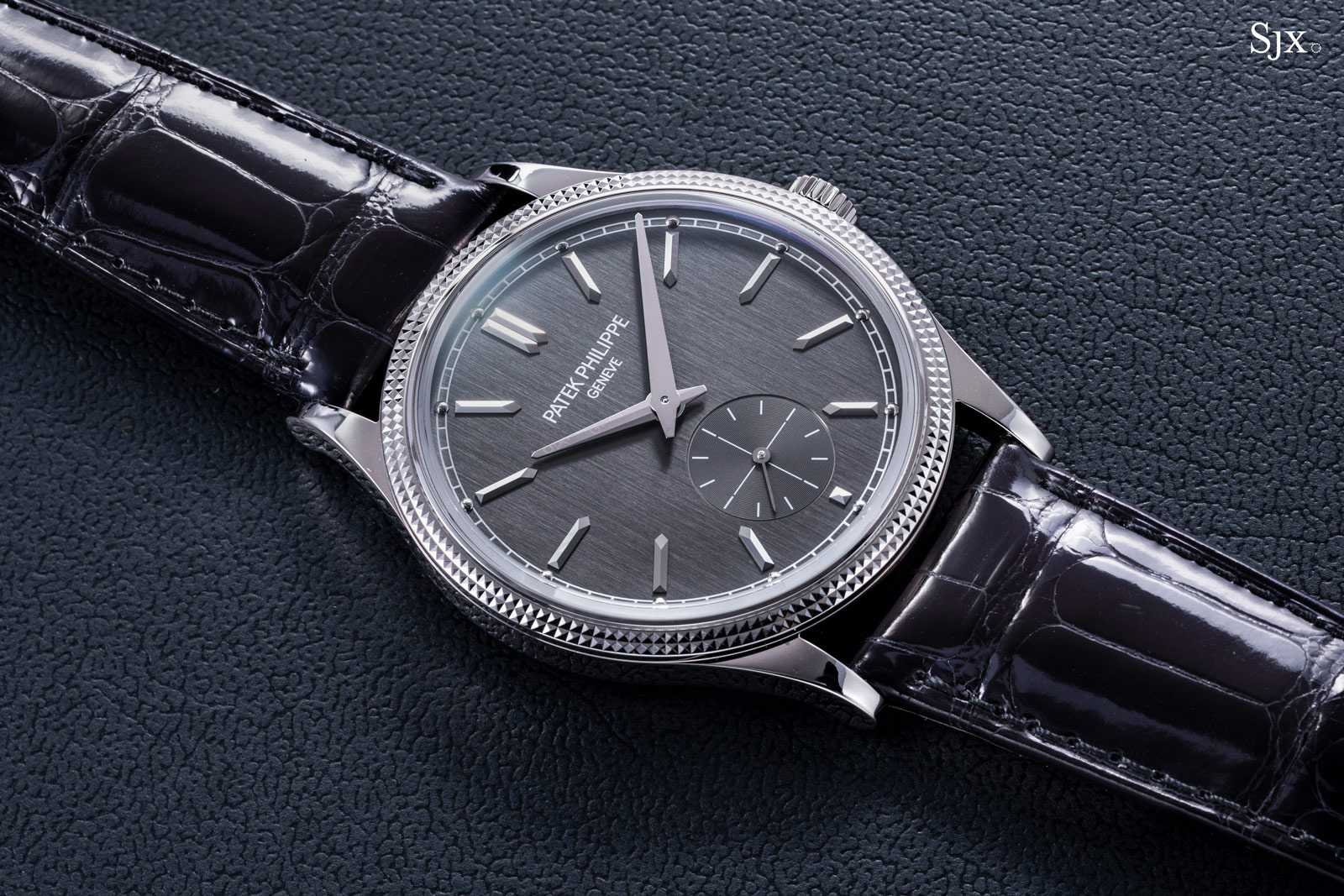
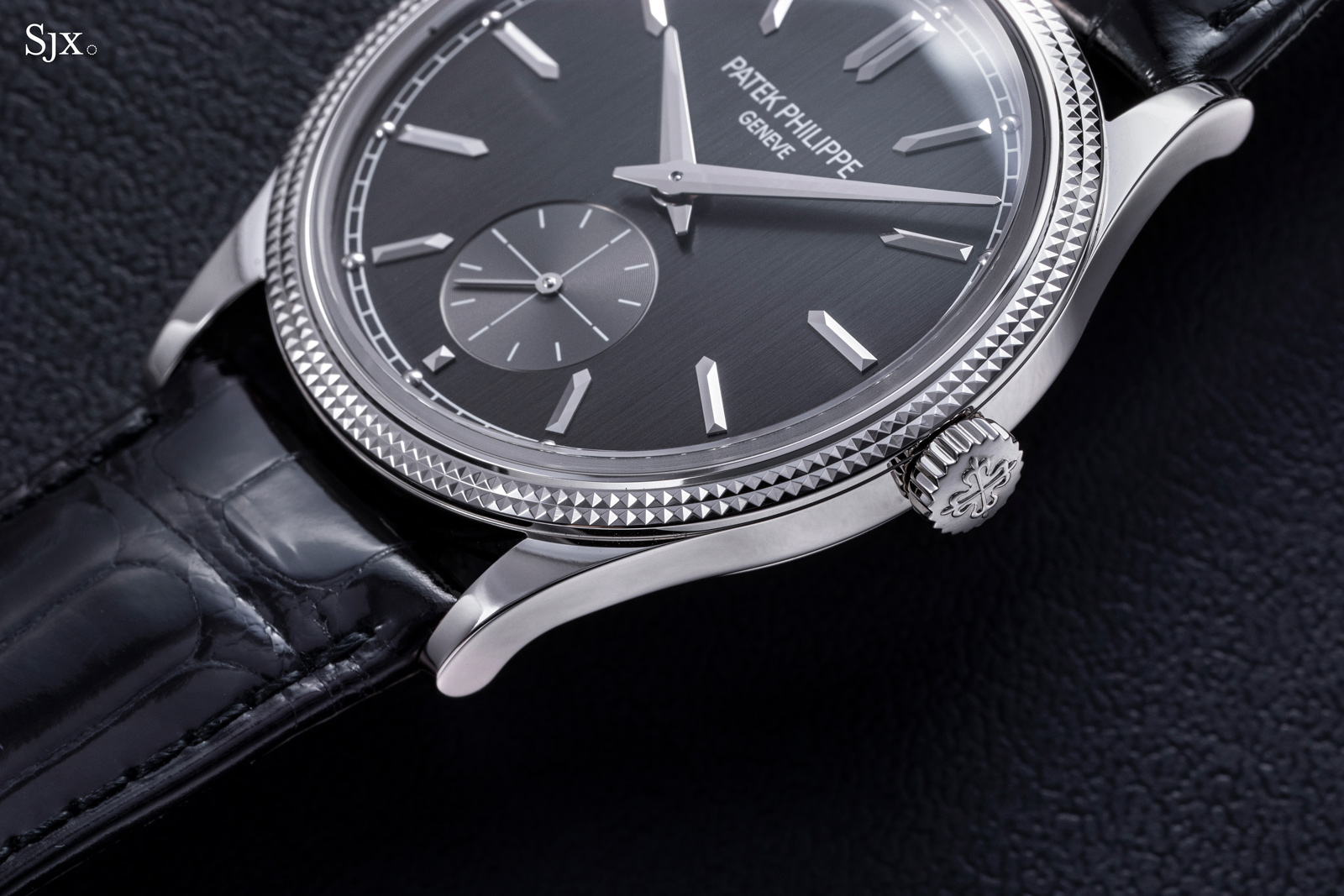
It’s a bit more formal looking in rose gold, but both versions are equally elegant because the case is thin. It sits flat on the wrist.
Perhaps due to the diameter the watch feels thinner than it is. In fact, the ref. 6119 could even pass for an “ultra thin” with a bit of imagination.
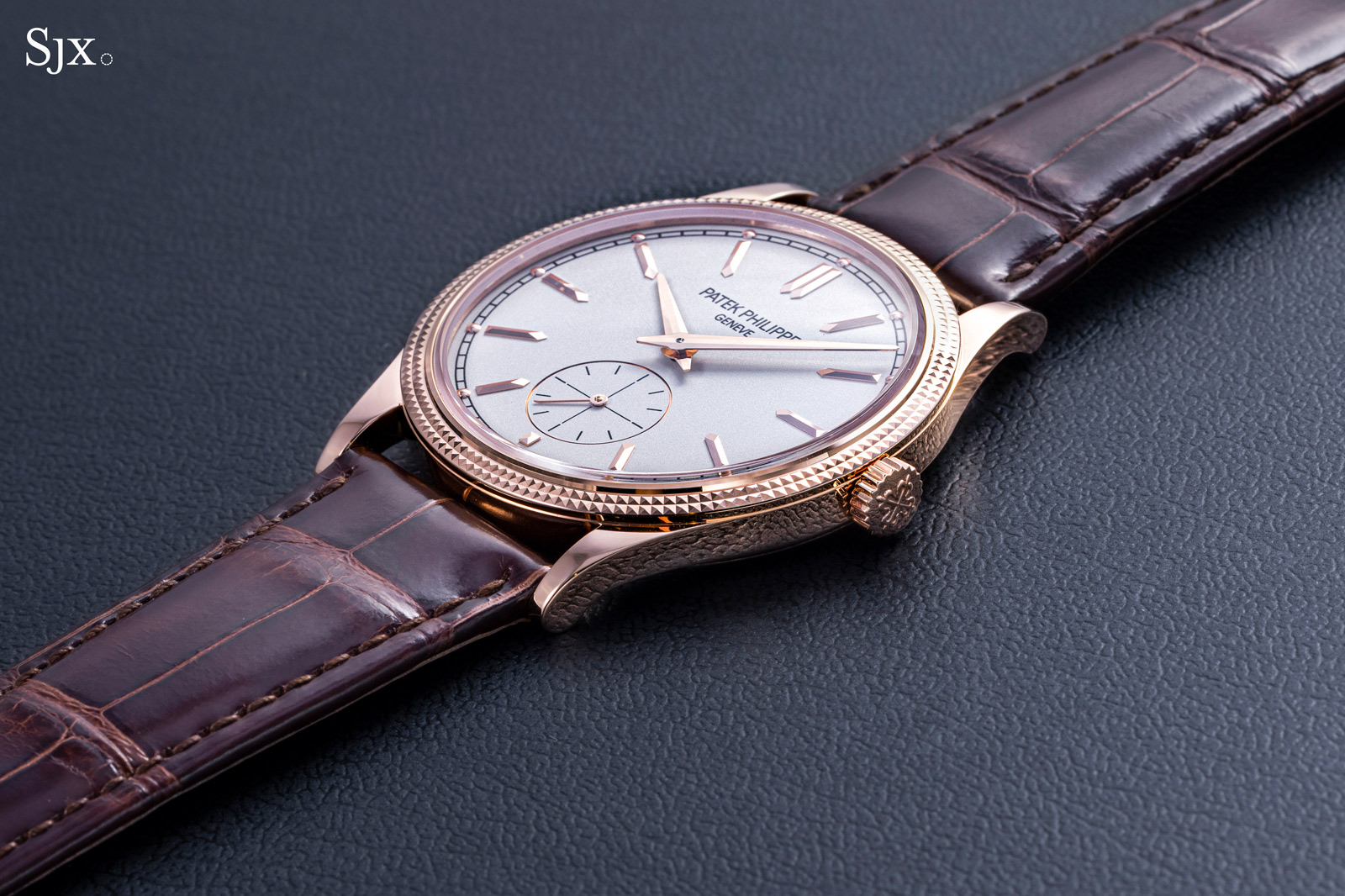
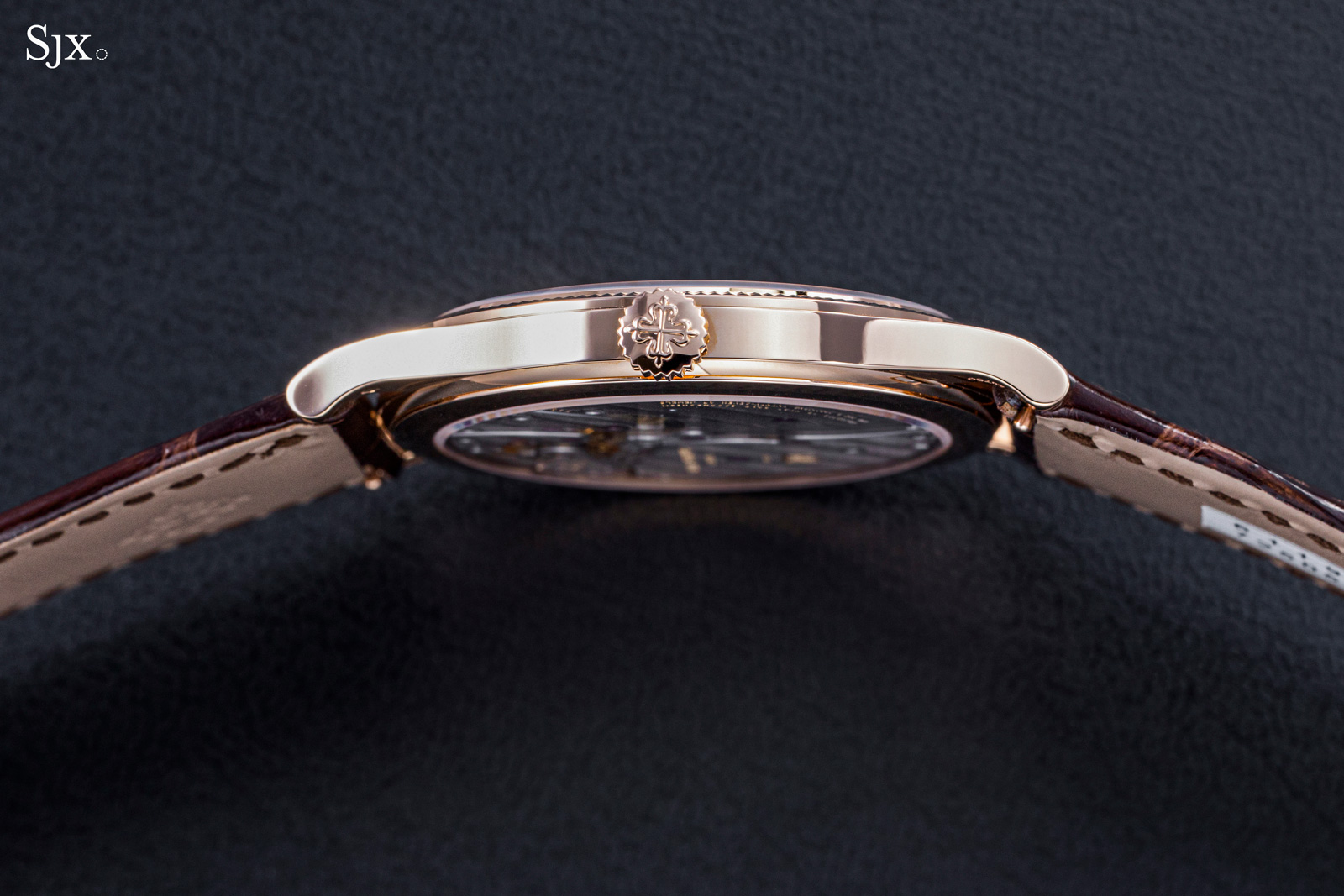
Part of its elegant, formal appearance is due to the mirror polish on all surfaces. Granted the case finish is not particularly interesting, but it is executed well and suits the dress-watch aesthetic perfectly.
The case is largely similar to the cases of past models in both quality and construction, though certain hidden elements have probably been refined, like how the press-fit back is secured.
One consequence of the thinness is the press-fit back (instead of a screw-down back), which does away with the tab found on the back of the ref. 5196, resulting in an attractive and seamless view on the back.
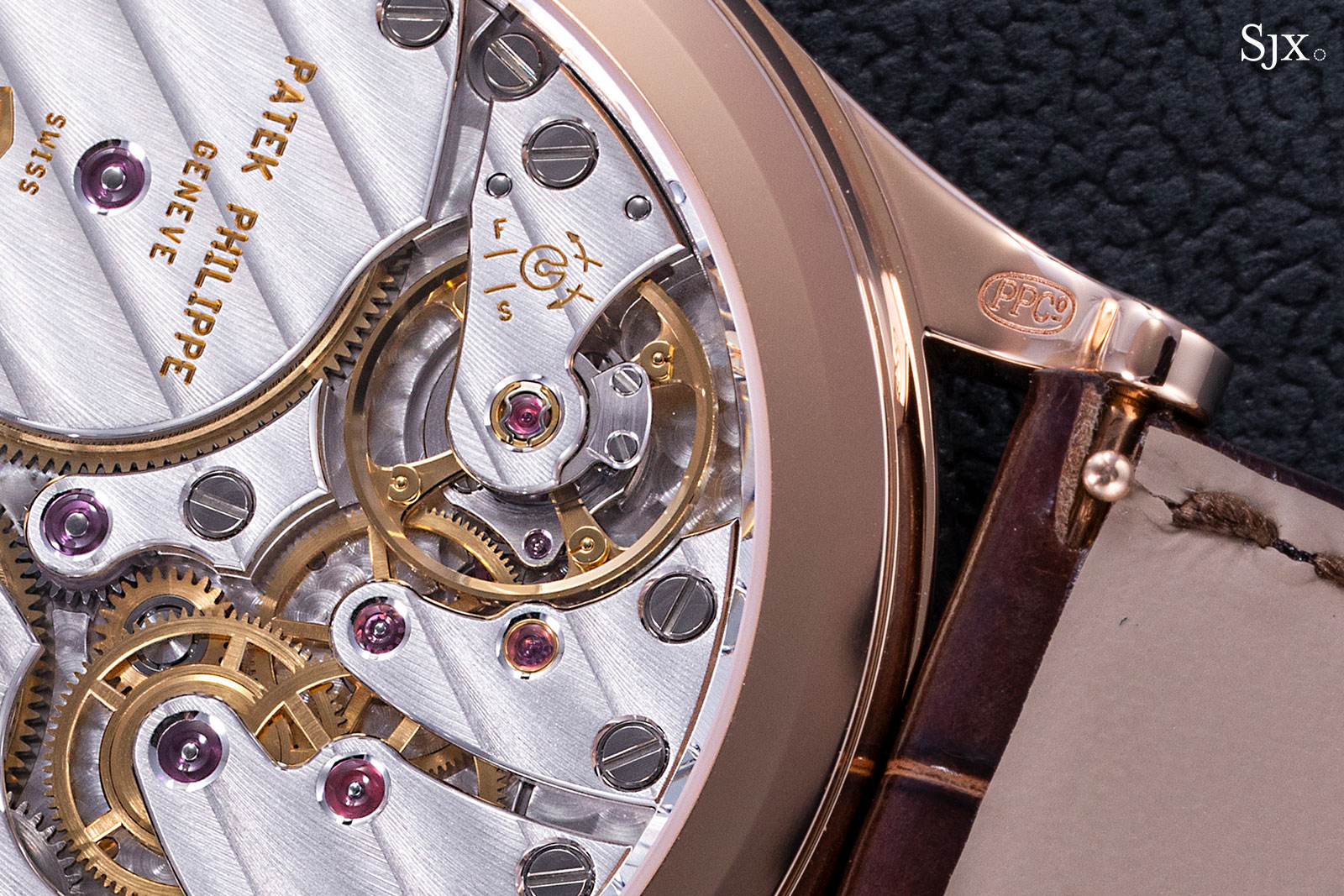
The “PPCo” hallmark on the reverse of a lug
Dial details
While the case is comparable in quality to past Calatrava models, the dial is significantly more elaborate. It’s an evidently a simple dial in terms of design, but it’s been executed with appealing details. Most of the details also give the watch a fresh, modern look, despite being modelled on vintage designs.
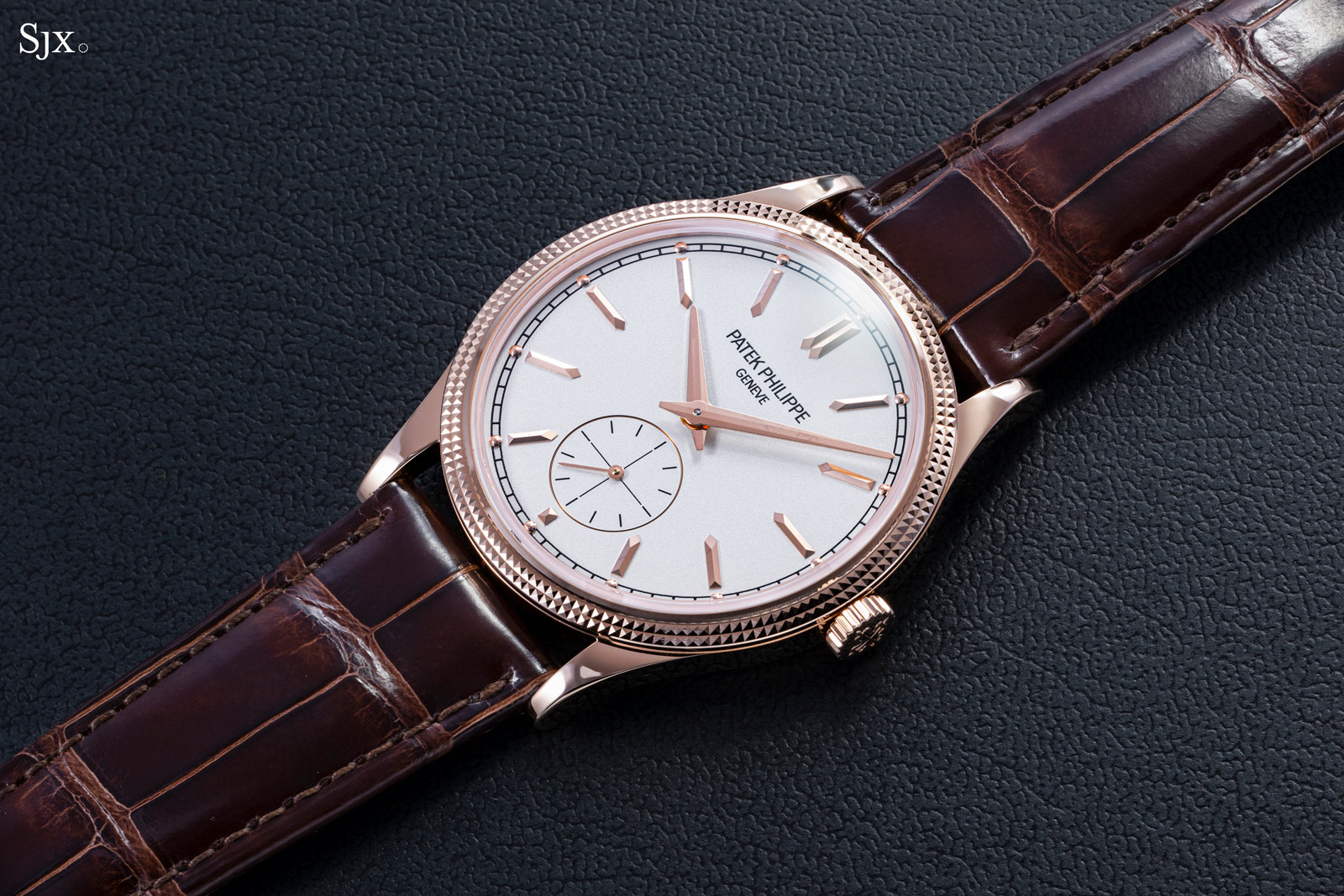
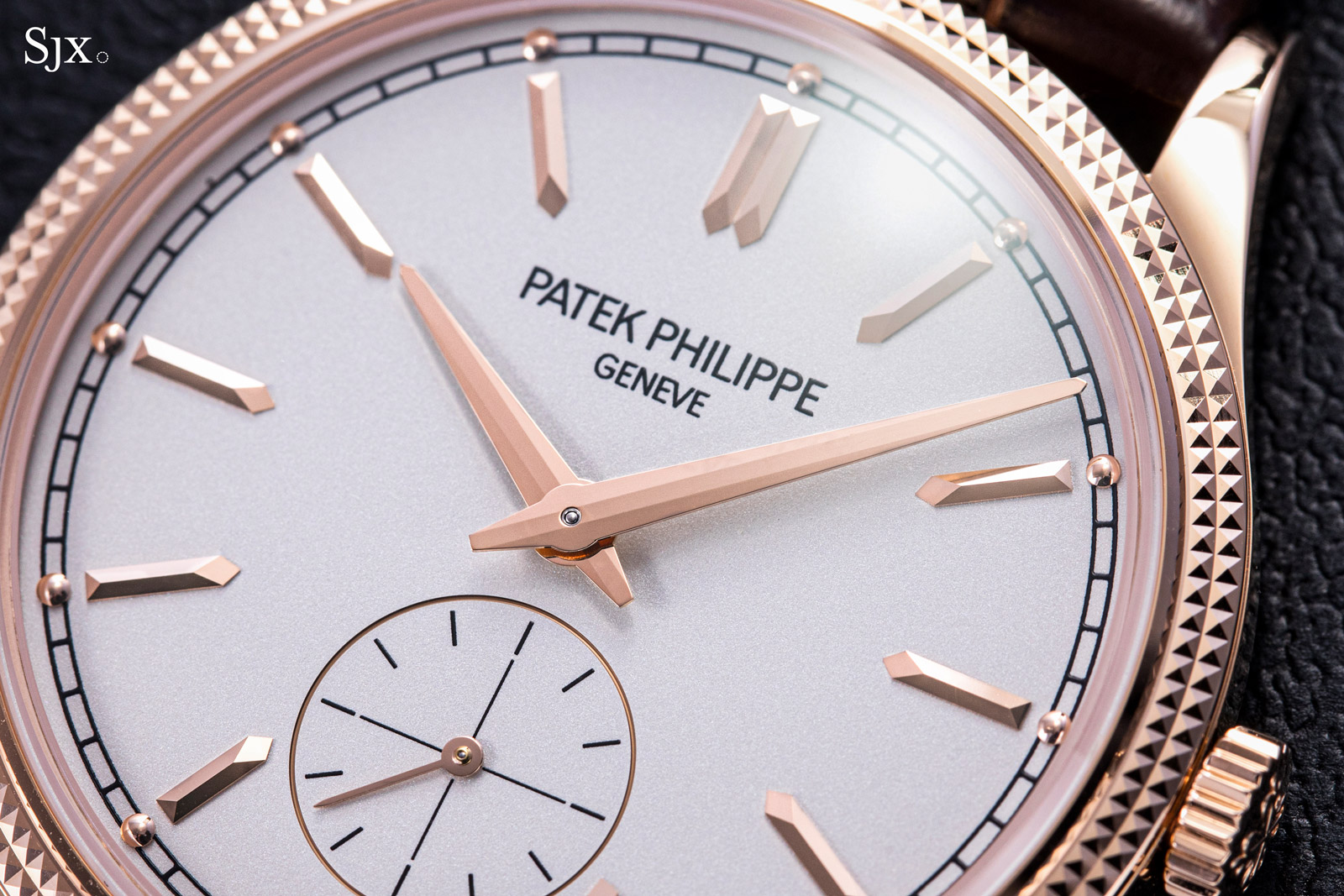
Most unusual is the bold, railway minute track. On its face, the functionality of a railway track would seem incongruous with a dress watch but it works well on the ref. 6119. It matches the crosshairs on the seconds sub-dial, another detail that would mostly be associated with a sporty watch or a “scientific” dial.
The minute track is one of the most important elements behind the modern look of the dial, with the other being the hands.
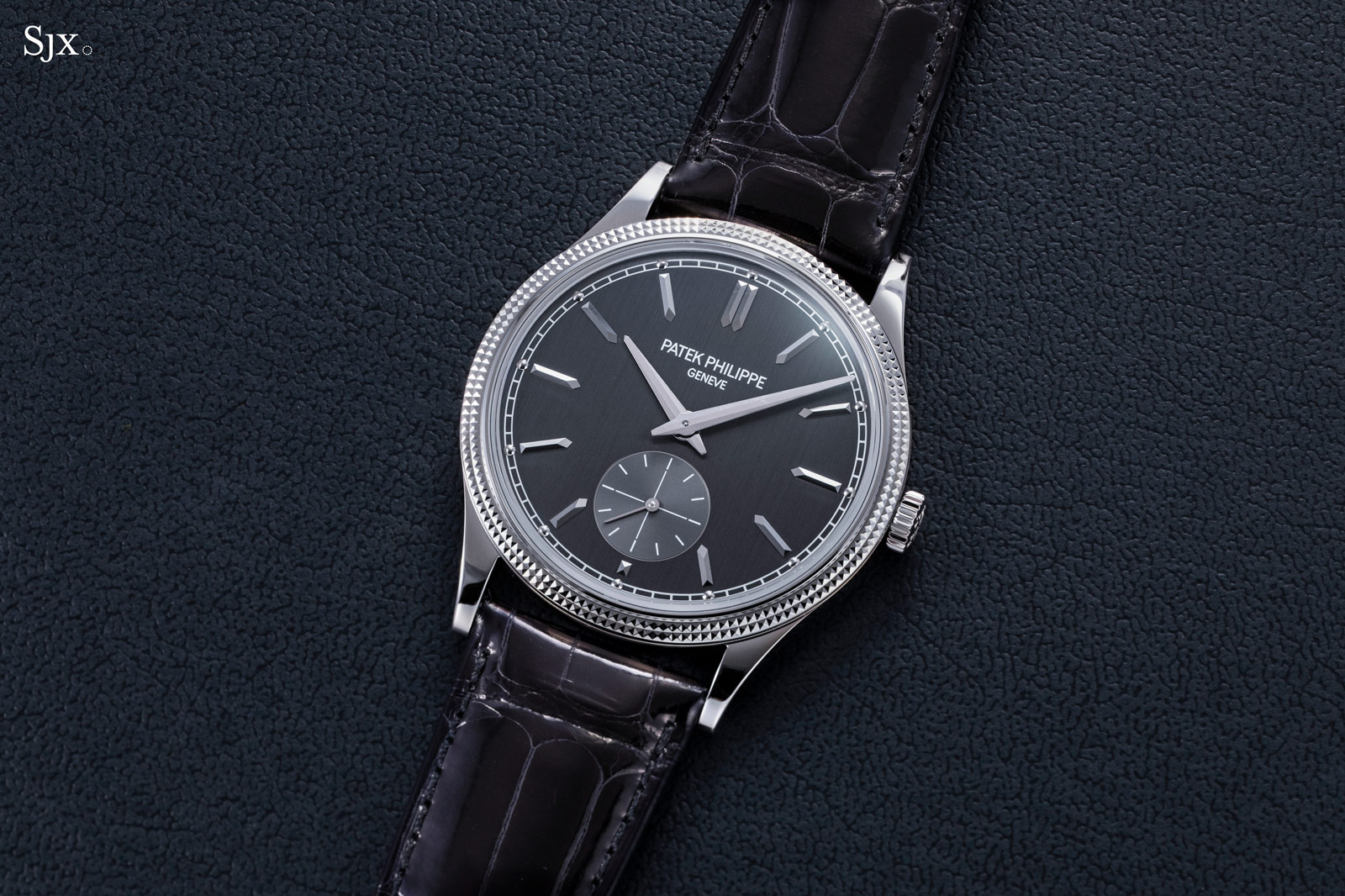
The minute and seconds scales on the white gold version are in white, making it even more modern
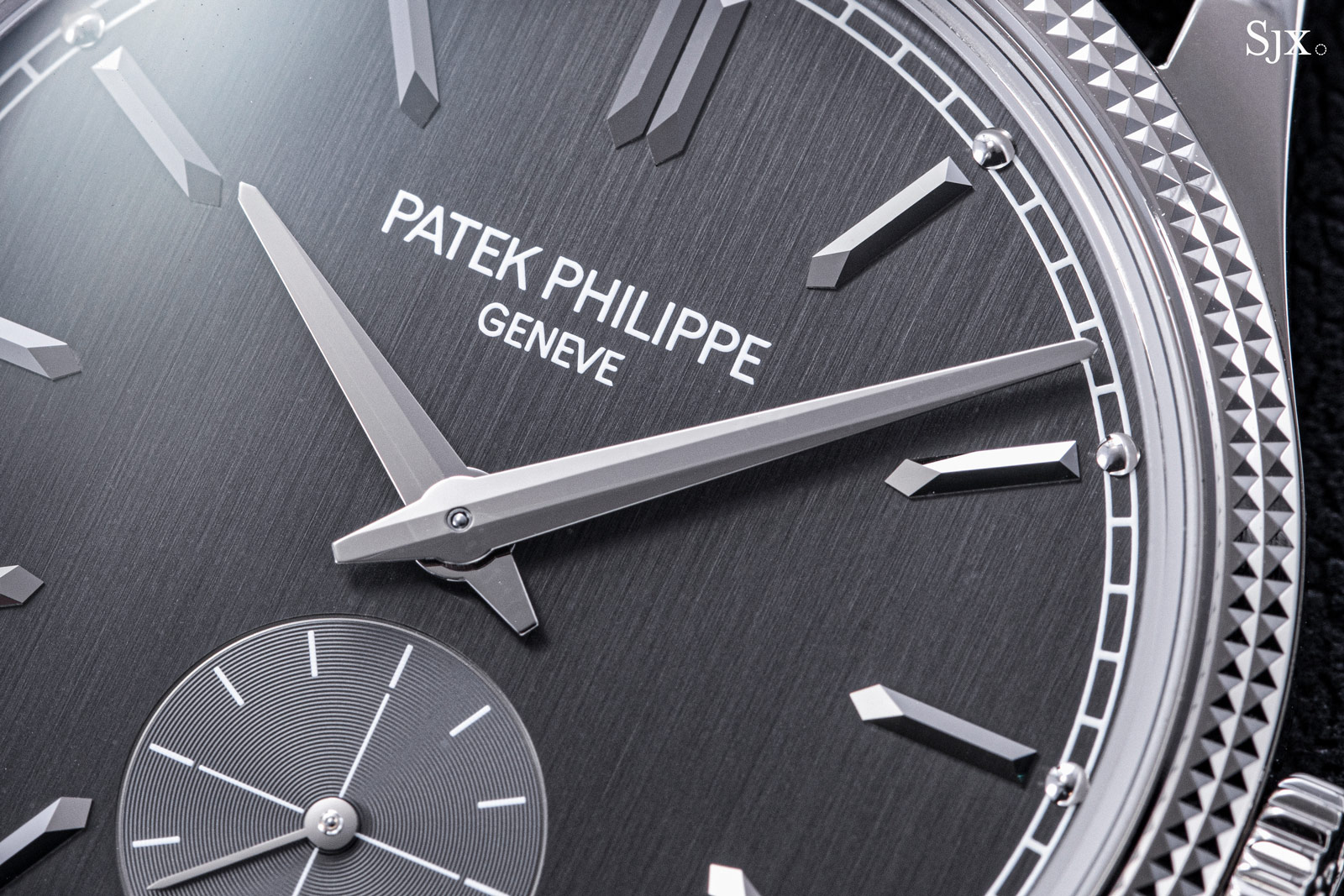
At a distance, the hands can be mistaken for dauphine hands, historically the most common style of hands on the Calatrava, especially the ref. 96 and its descendants. But the hands of the ref. 6119 are a modern creation.
They are facetted thrice lengthwise, creating three faces on the hands, while having short but wide counterweights. As a result, they bring to mind hands found on sports watches. The hands are definitely a key part of the modern look, but they aren’t the best fit for the design in my opinion.
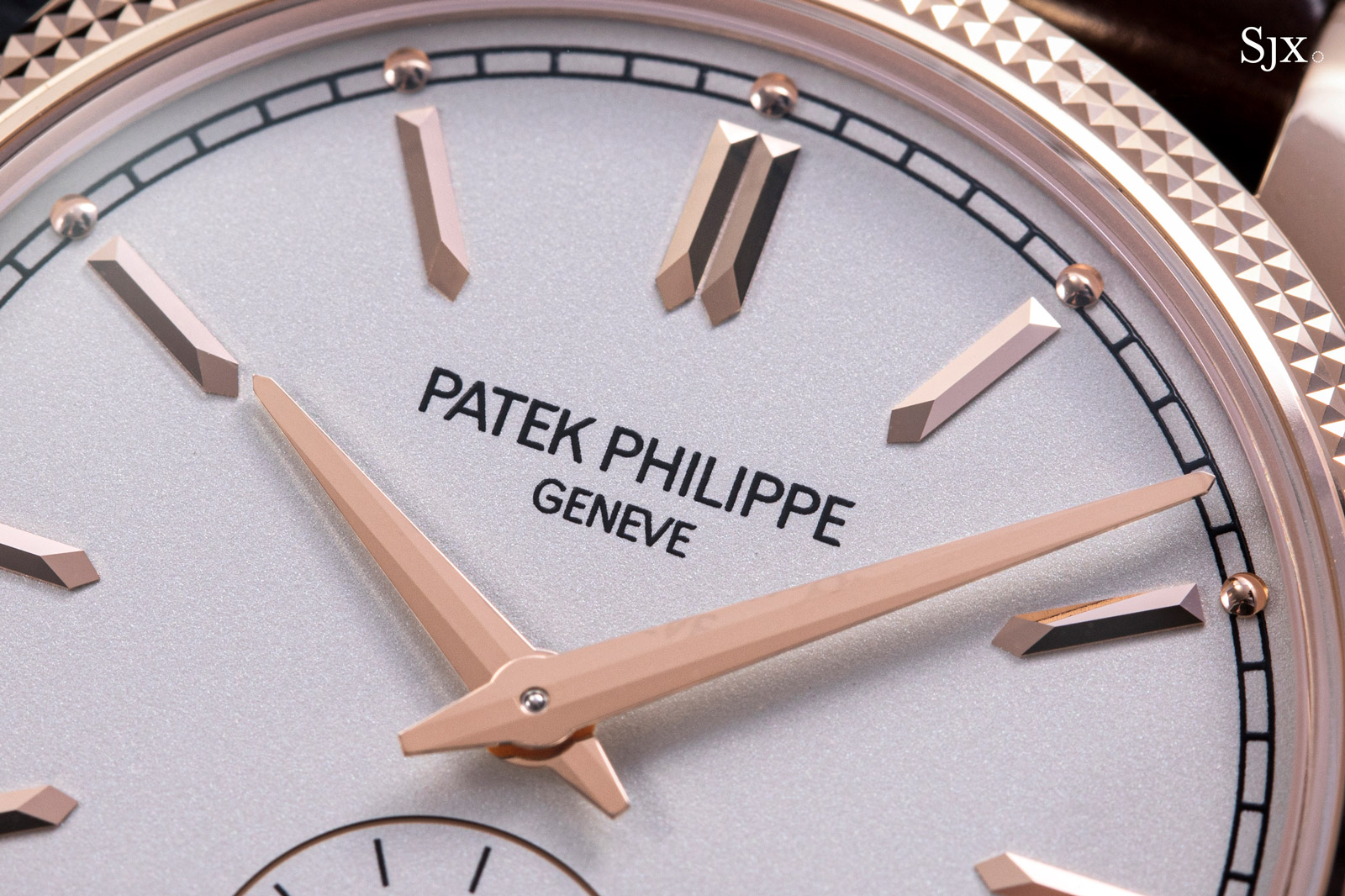
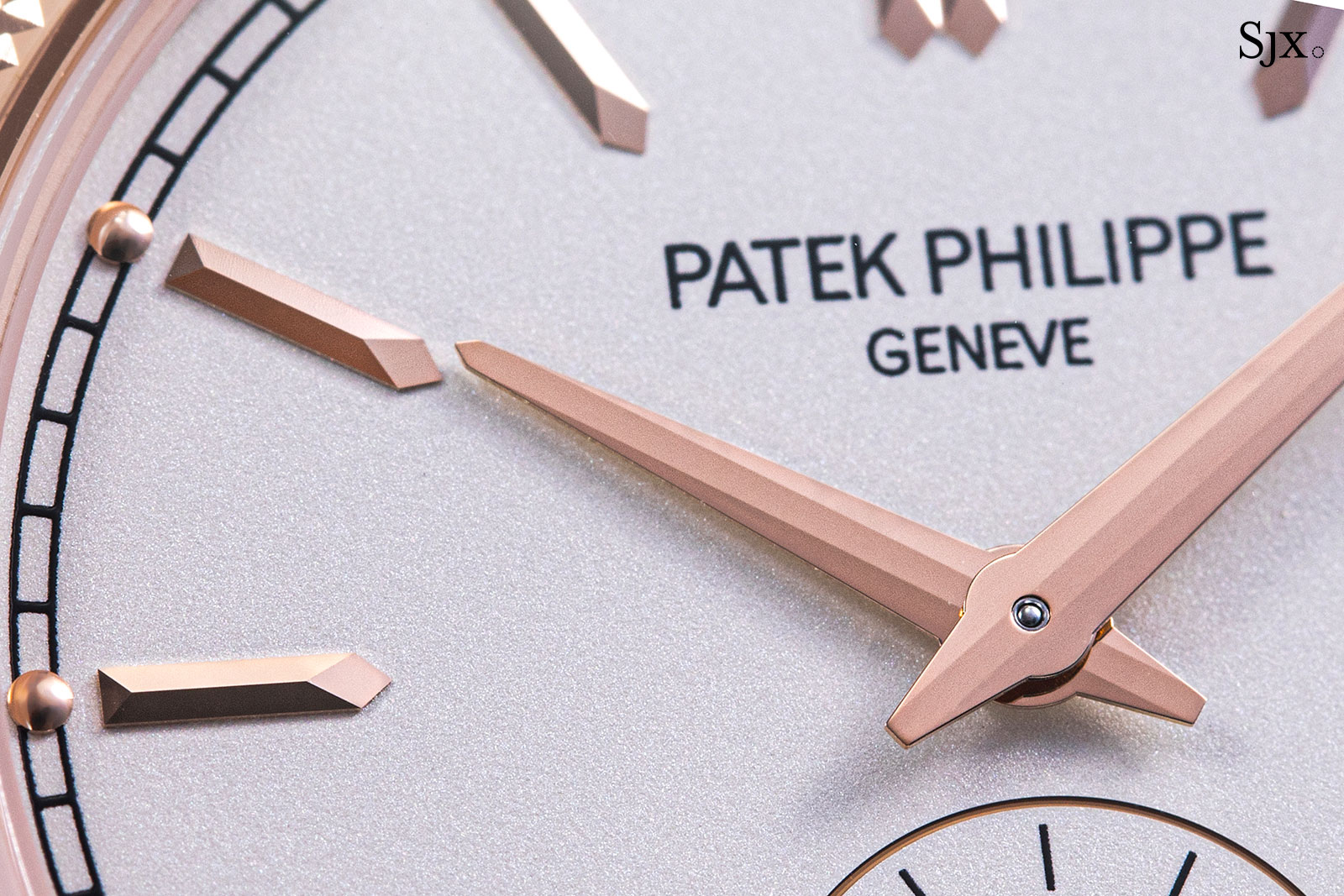
In contrast, the baton hour markers are entirely classical. They’re identical to that found on the vintage ref. 96 and many subsequent Calatrava models, but refined slightly. They have steeper bevels, resulting in a sharper lower point.
More unusual are the spherical minute markers – which mean the dial has twin rows of applied markers. Once again they are inspired by similar markers found on vintage dials, but there they are affixed to the railway minute track, and serve to emphasise the modern look.
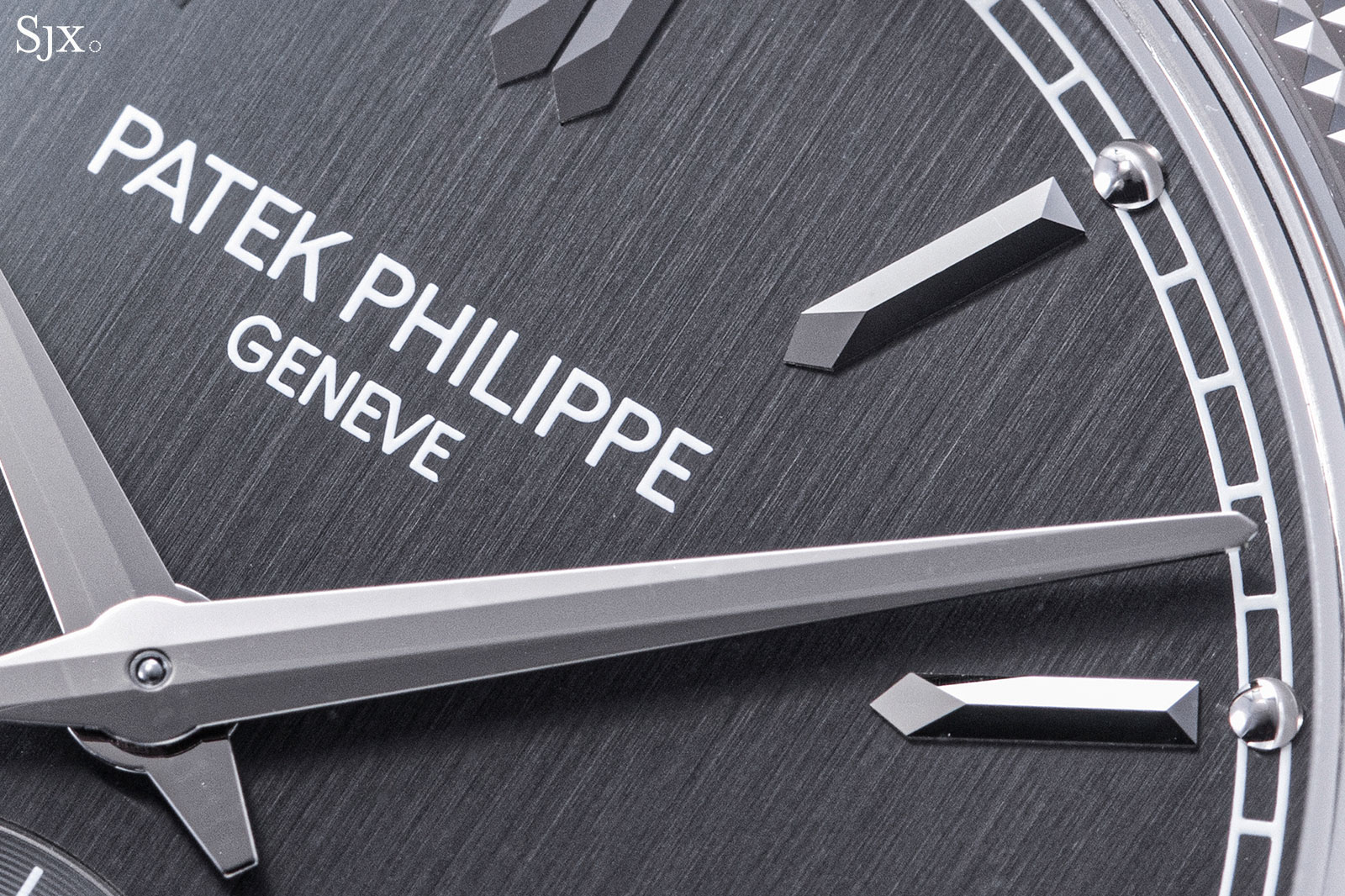
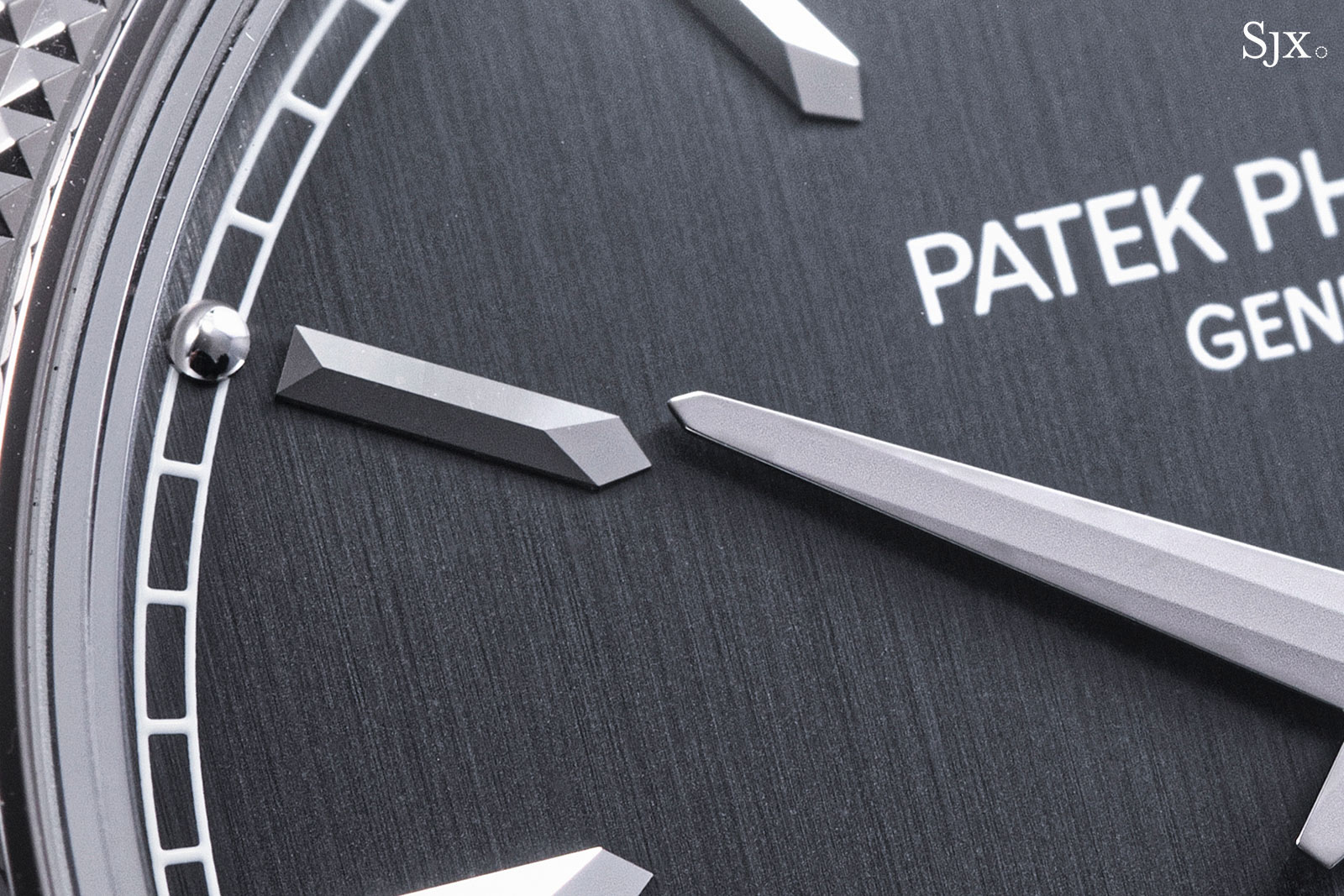
Though both versions of the ref. 6119 are alike, they differ subtly in their dial details. Each dial is finished in a manner that best suits the version.
The rose gold model has what you’d expect on a conservative dress watch, a finely-grained, silver dial. The seconds register is similarly silvered and grained, but embossed with a faint concentric pattern that’s almost invisible.
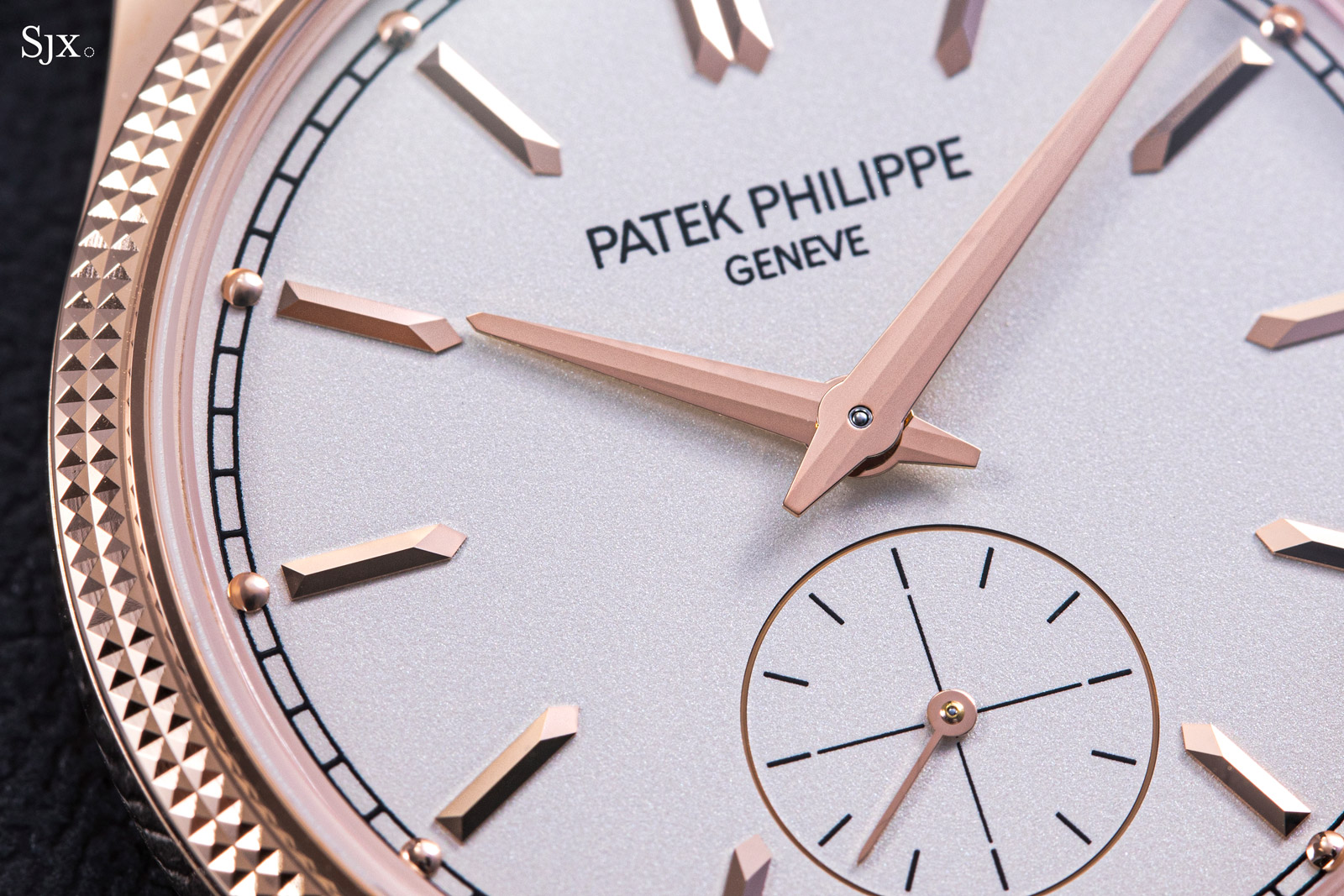
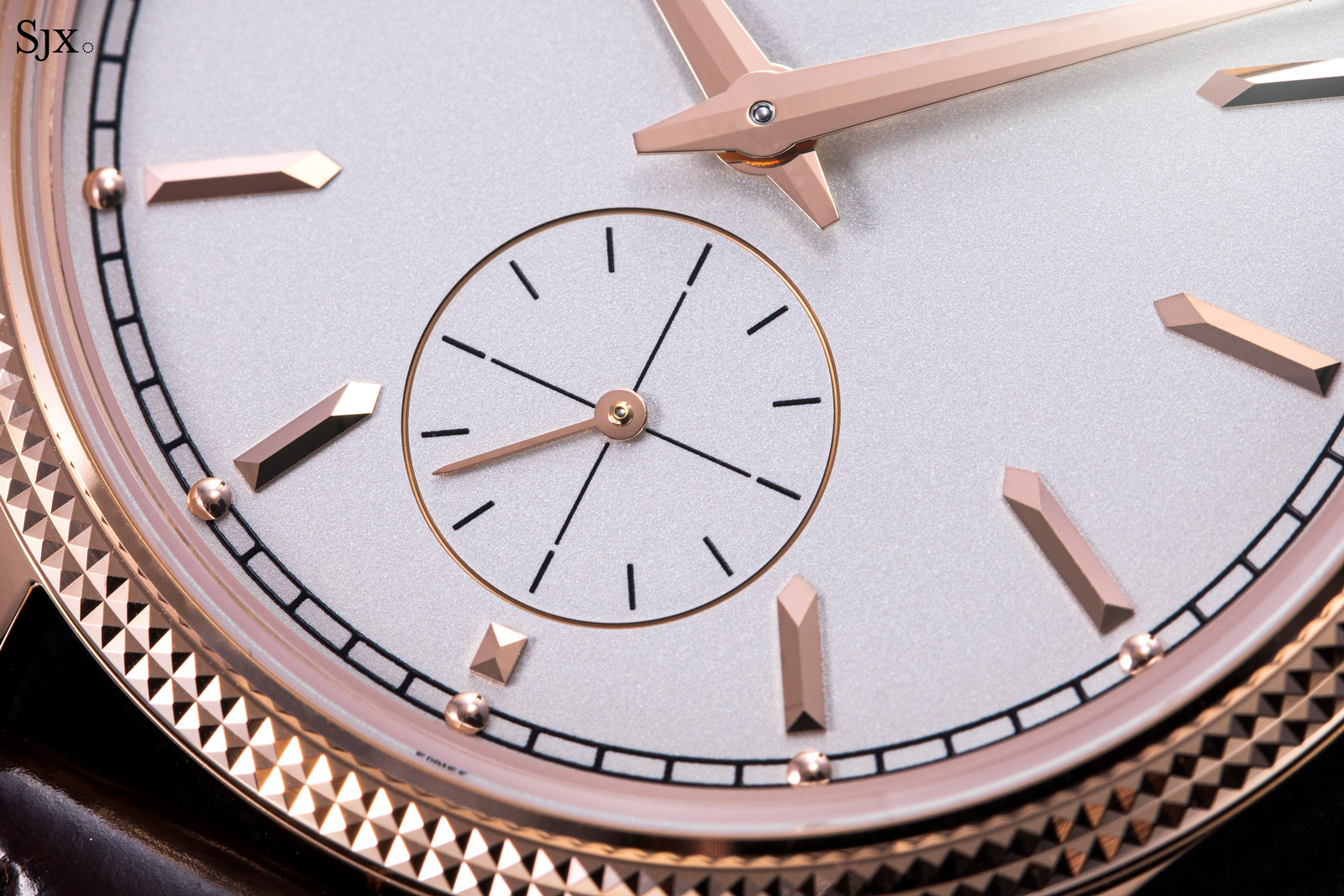
The gilded border around the seconds is more apparent on the gold version
The white gold version, on the other hand, has a more striking dial finish. It has a pronounced vertical graining that’s rarely used by Patek Philippe and only found on the ref. 5235 and ref. 5236.
Because of the finish, the grey dial varies in hue depending on the light and angle, unlike the silvered dial of the rose gold model that mostly looks the same.
And the grey dial also has an obvious two tone finish because of the concentric pattern on the sub-dial, which results in a paler grey colour.
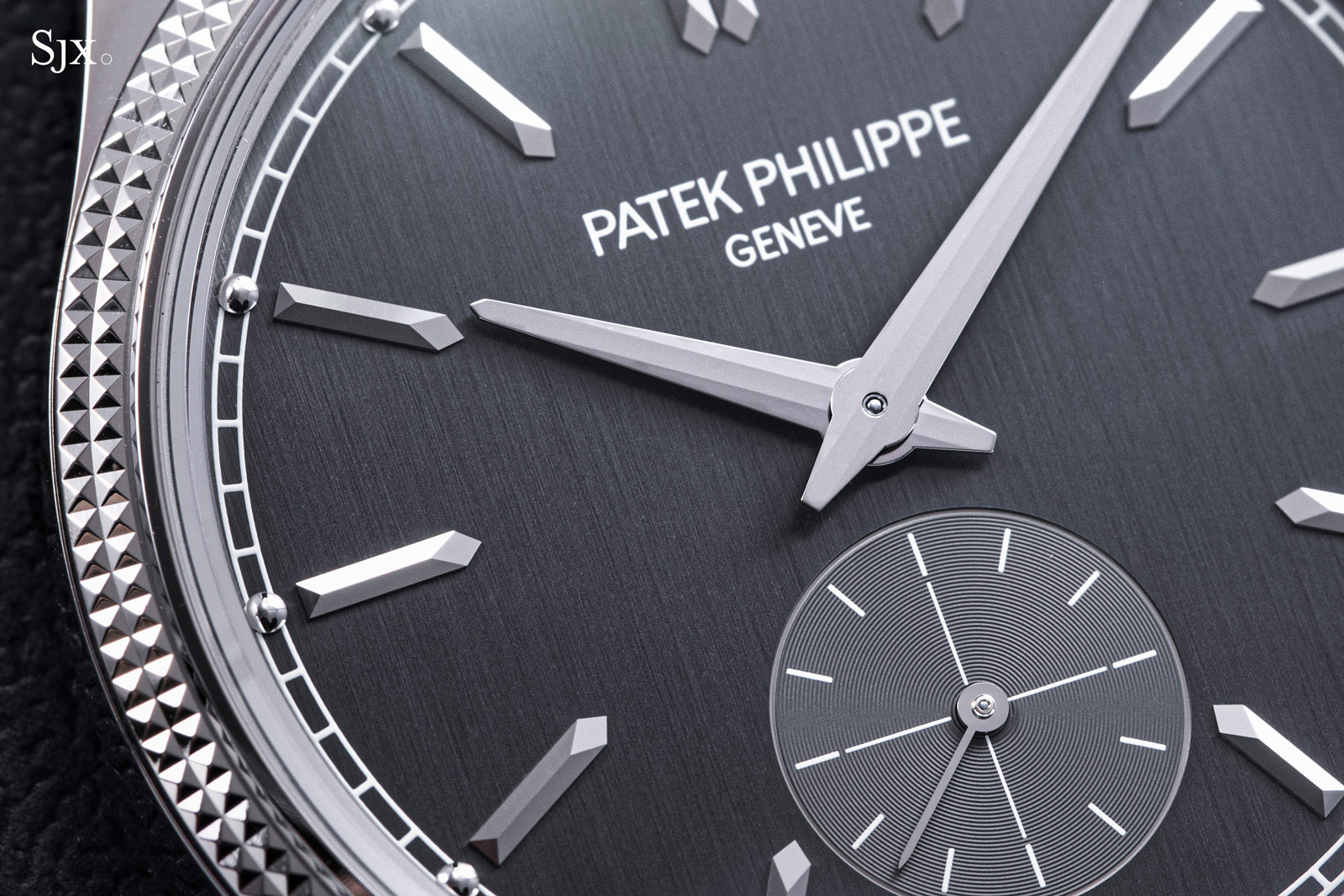
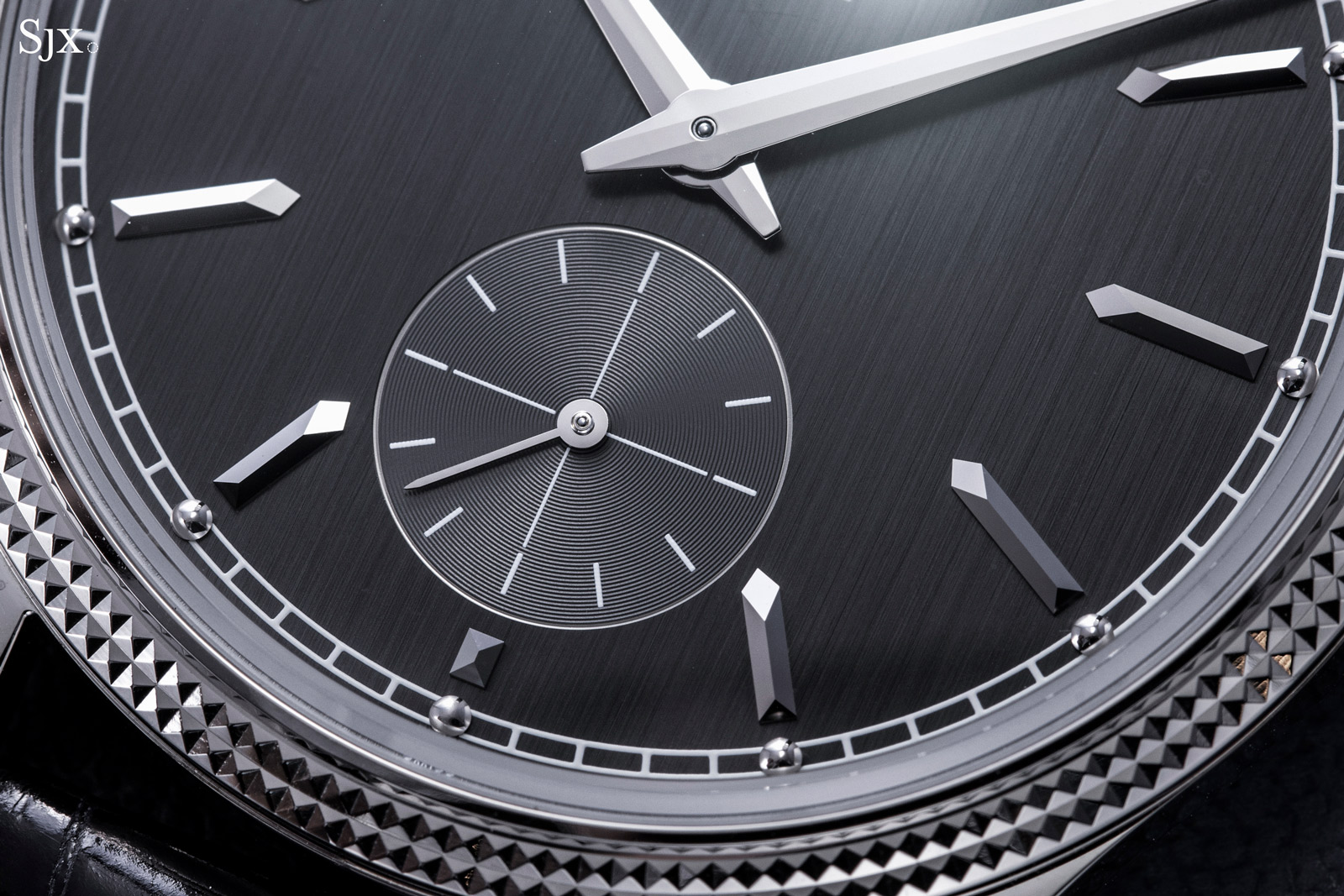
The seconds is a lighter shade of grey
A new movement
Arguably, the star of the show however, is the new movement – the cal. 30-255 PS. Before exploring the movement in detail however, it is worth discussing the significance of the new movement.
Prior to this, three movements were ubiquitous in Patek Philippe’s entry-level, three-hand watches – the cal. 324/330 and cal. 240 for automatics, and in hand-wind models, the cal. 215, which will be replaced by the cal. 30-255 PS.
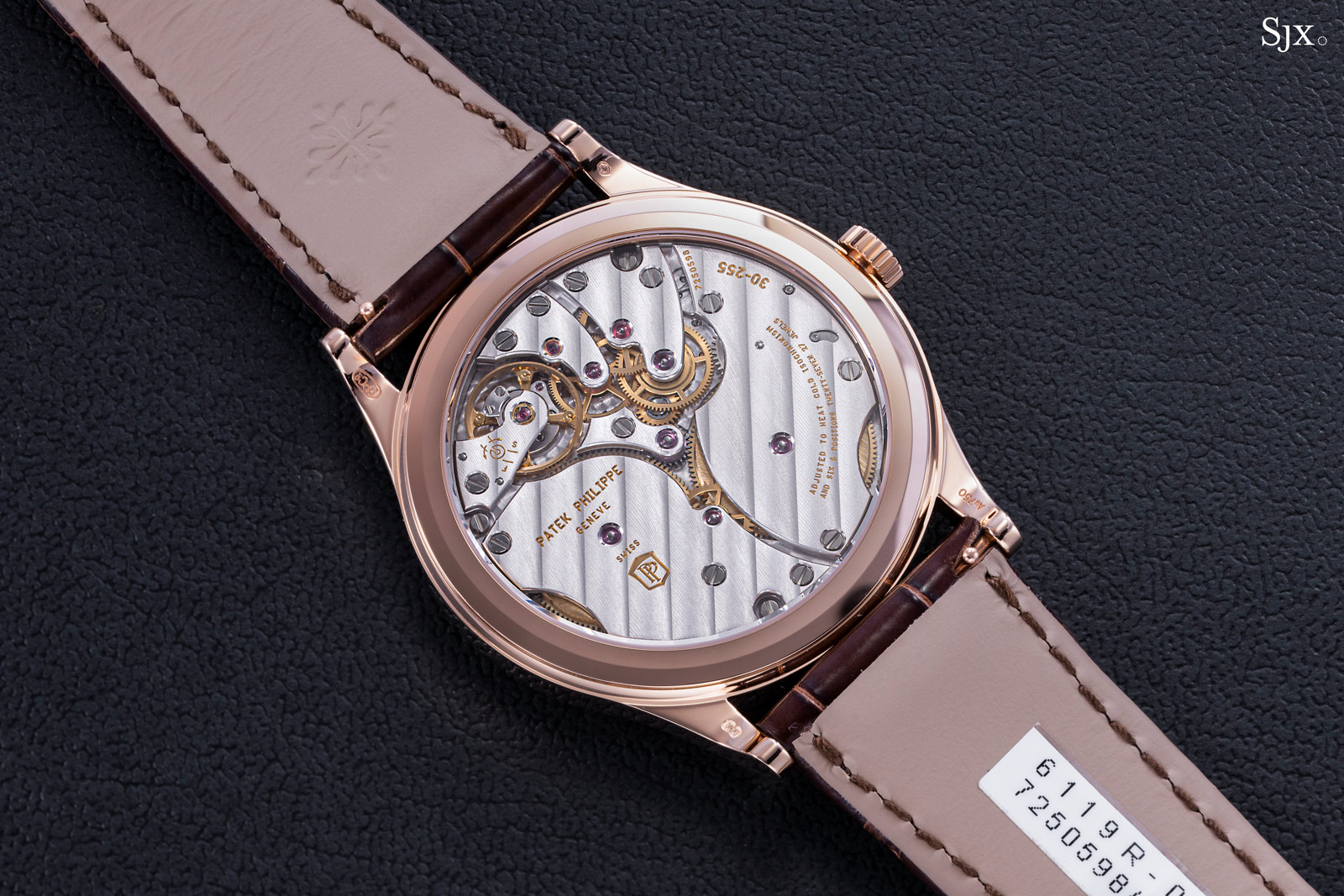
Almost 50 years old now, the cal. 215 is tiny by today’s standards at just 21.9 mm across, making it too small for modern watches that are mostly 38 mm or larger. The ref. 5196, for instance, is 37 mm in diameter, almost twice as wide as the cal. 215.
At 31 mm in diameter, the new cal. 30-255 is ideal. The movement size implies the cal. 30-255 will be found widely utilised beyond the ref. 6119, making the new Calatrava merely a taste of things to come. And the size has implications for the look of the Calatrava for decades to come.
The larger movement indicates the brand’s dress watches will be larger, with future Calatravas being 38 mm or larger. And anything smaller, including ladies’ watches, will continue to rely on the cal. 215, until a similarly sized replacement comes along.
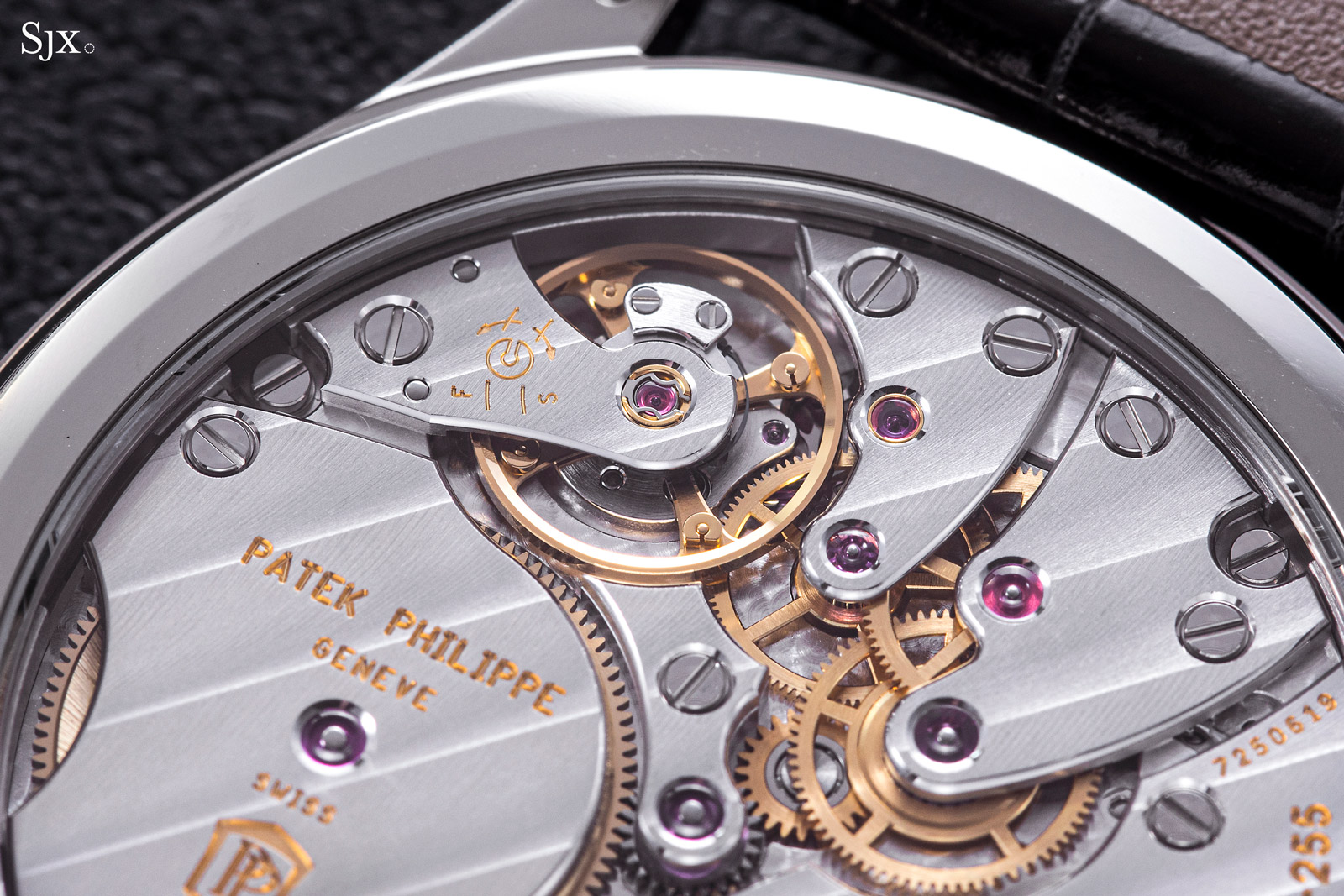
But the cal. 30-255 is not merely a bigger movement, it is a better movement. It boasts upgrades that improve the user experience and performance. In summary, it has a longer power reserve of 65 hours, hacking seconds, and will keep better time in theory due to its construction.
And in terms of dial design, the larger movement allows the seconds at six o’clock to be located closer to the edge of the dial, resulting in better proportions.
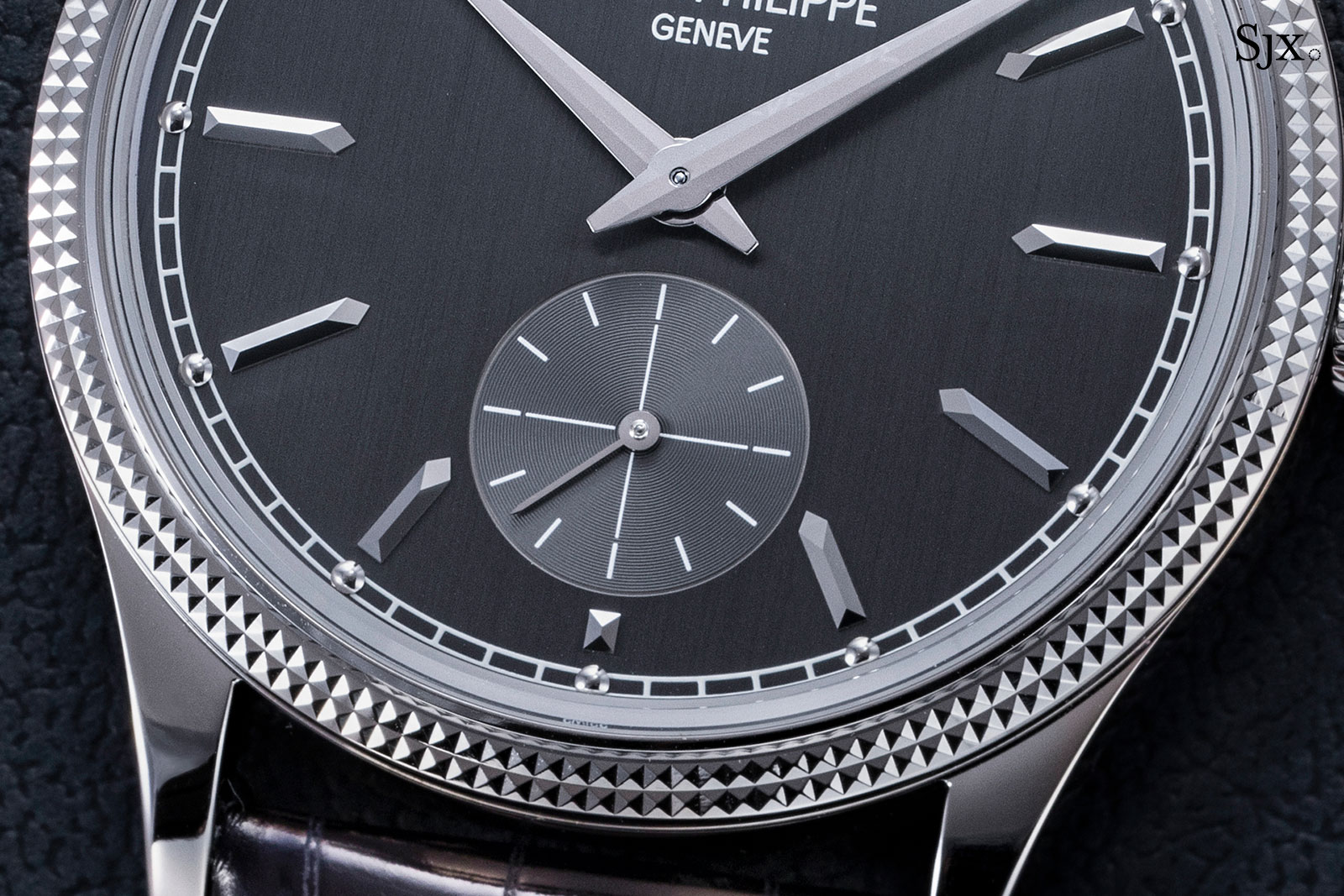
The seconds in an ideal position
High energy density
The cal. 30-255 is not merely a rehash – it is neither a scaled-up cal. 215 nor derived from a historical pocket-watch calibre. Instead, the movement was clearly developed from the ground up to optimise nearly every inch of space available – despite being large there’s no laxness in its design – leading to a technically superior construction.
The most prominent feature are the twin mainspring barrels. Impressively large, the two barrels are arranged in a parallel configuration to provide high torque to the going train that remains relatively constant over its running time.
While the twin-barrel setup isn’t novel in itself, the cal. 30-255 marks the first time that Patek Philippe has installed twin barrels in a time-only movement – in fact, it’s a first amongst the “Holy Trinity”, for neither Audemars Piguet nor Vacheron Constantin have done so.
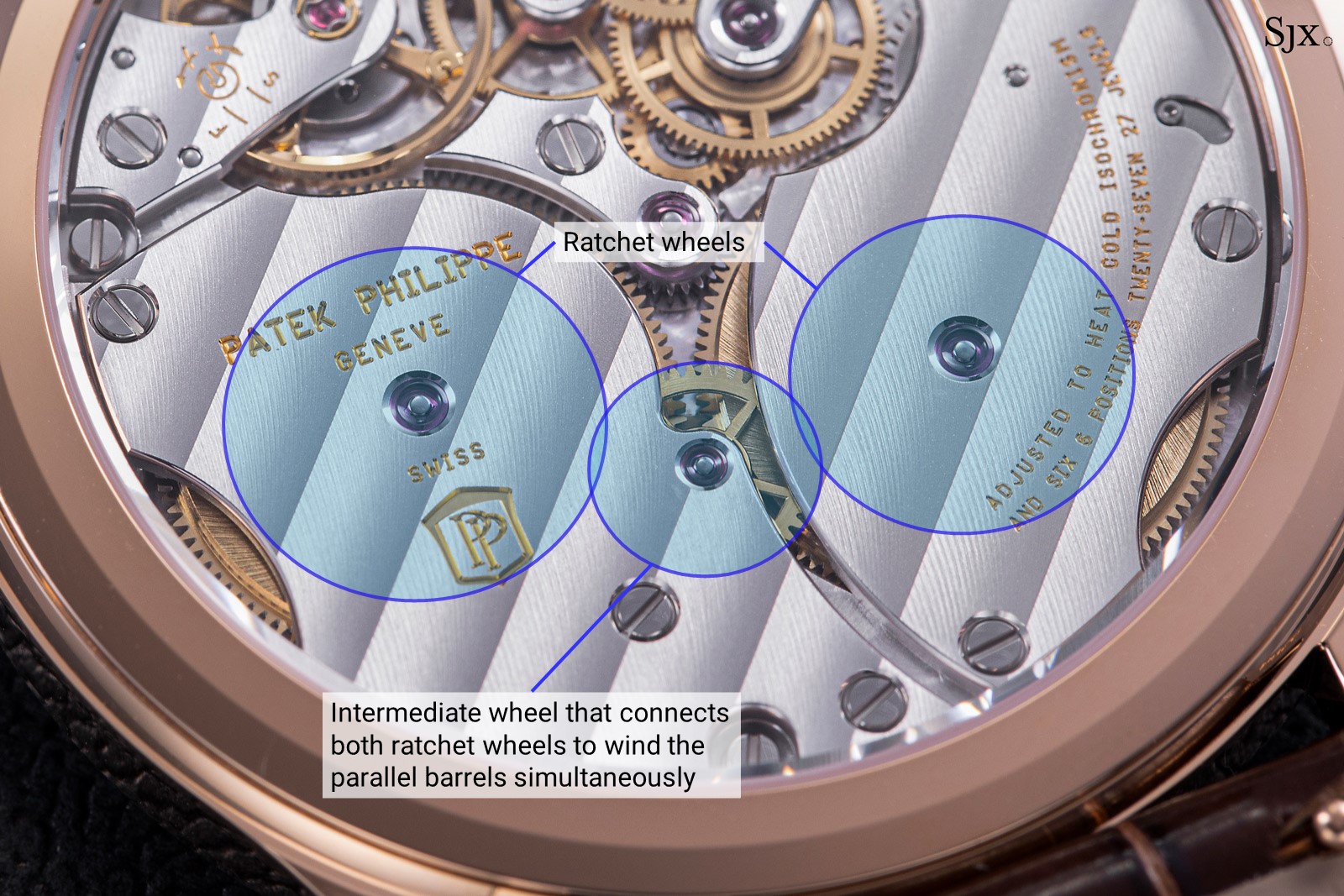
The high torque is required for good reason – the balance wheel beats at the modern norm of 4 Hz, or 28,800 beats per hour. But what is impressive is the inertia of the balance, which Patek Philippe notes is double that of its predecessor, the cal. 215.
Higher inertia means a balance wheel is heavier. To illustrate: with two balances of identical diameters, one balance would have to be twice as heavy with a rim twice as thick, in order to double its inertia.
A high moment of inertia is useful because it means the balance is less susceptible to external disturbances like shock or movements of the wrist – even in the face of a disturbance, the balance will tend to keep swinging as before due to its larger inertia. That’s the reason why it is more difficult to stop a heavier car than a lighter vehicle travelling at the same speed.
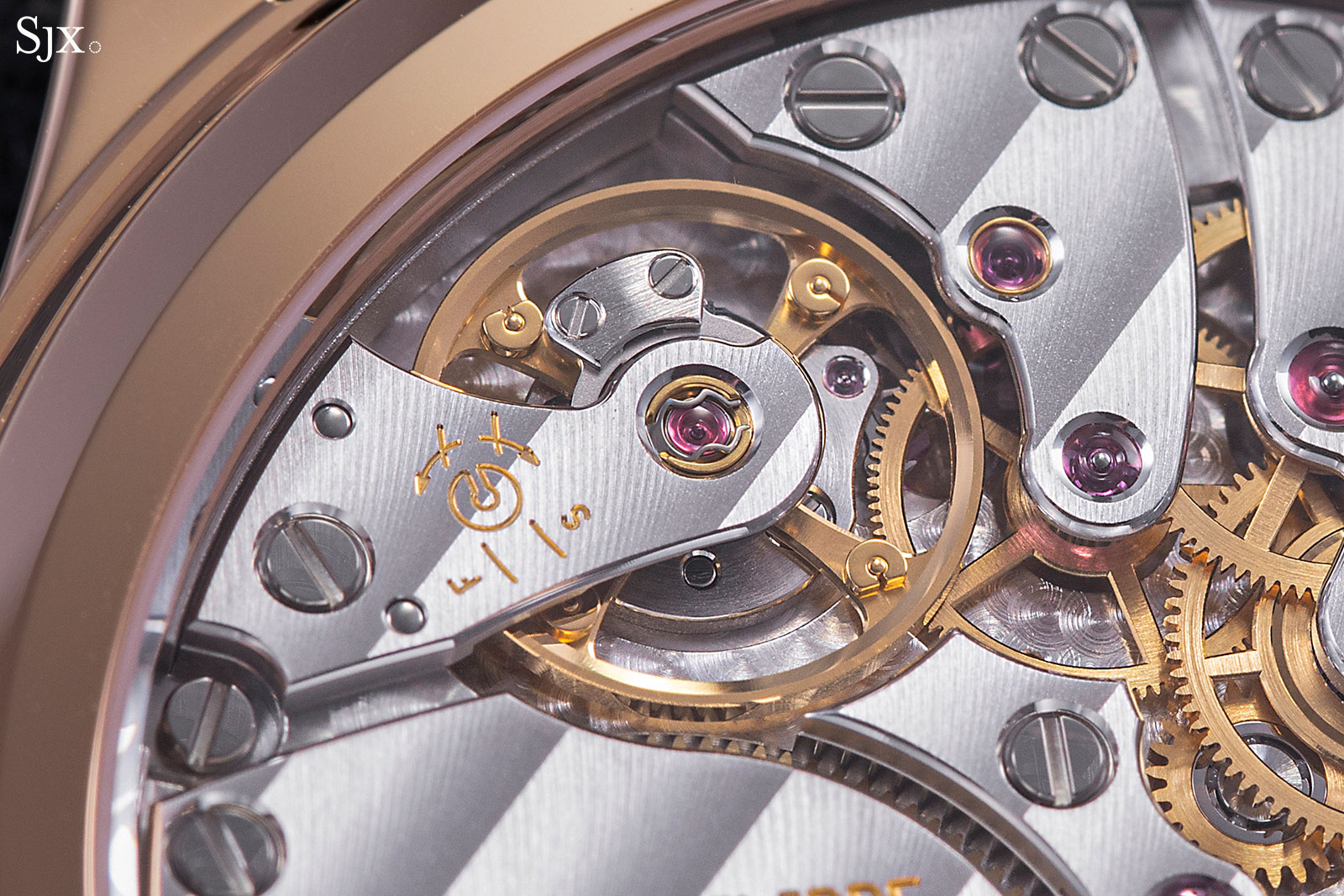
The balance wheel is free-sprung and the hairspring is flat –standard fare for Patek Philippe at this price point
Much like a heavier vehicle, a high-inertia balance wheel need more energy to oscillate. Thus, the beat rate of heavy balance wheels are often reduced to 3 Hz or 2.5 Hz as a matter of practicality, mainly to optimise the power reserve.
But thanks to the large twin mainsprings, the cal. 30-255 has a heavy balance wheel that can run at the modern standard of 4 Hz. That is a good thing – a high inertia balance wheel oscillated at a higher beat rate means timekeeping is more stable.
In short, this means the cal. 30-255 wheel has excellent HDF, which means its accuracy is theoretically impressive, and should be superior to most other Patek Philippe movements.
Intriguingly, the high torque of the cal. 30-255 should make it useful as a base movement for complications, such as perpetual calendars or maybe even a jump hour. That would be something to look forward to.
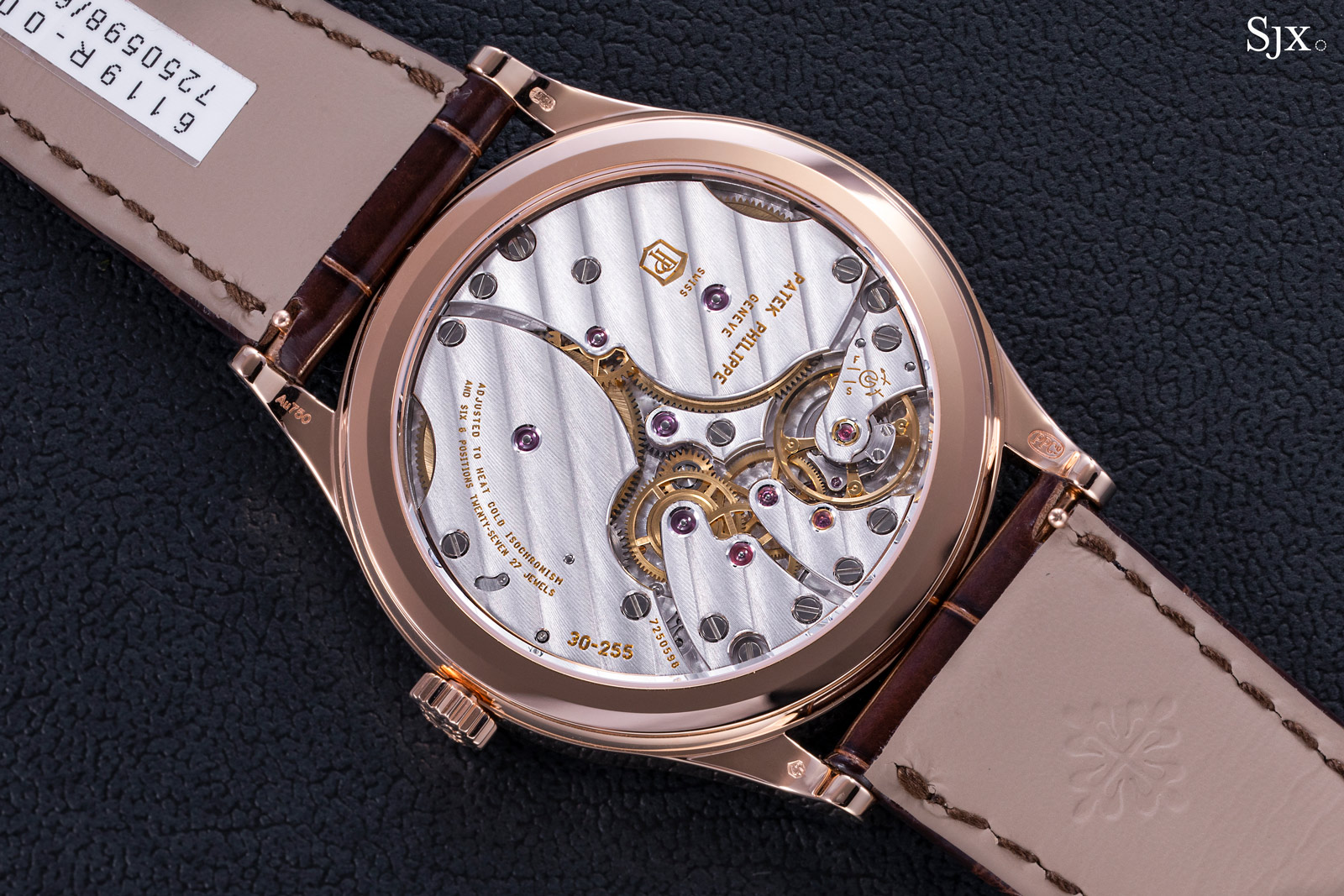
Filled to the brim
Returning to the barrels – one aspect of the movement that was evidently a key consideration during its development was thickness, or more precisely, thinness. Impressively, the cal. 30-255 is only 2.5 mm high – exactly the same as the cal. 215 – so everything is achieved by only increasing the diameter.
With two large mainsprings, fundamental to the construction is securing each barrel in place.
A common solution is an exposed barrel ratchet wheel that sits on the barrel bridge, as it does on the cal. 215. Here the central barrel arbor has to pass through a large bearing hole in the bridge, which then gets covered by the ratchet wheel on top, which has to be further held in place by a screw.
Notice the centre wheel (also known as the second wheel for its position in the gear train), which directly drives the minute hand as it makes one revolution every hour, is sandwiched between the barrel and ratchet wheel.
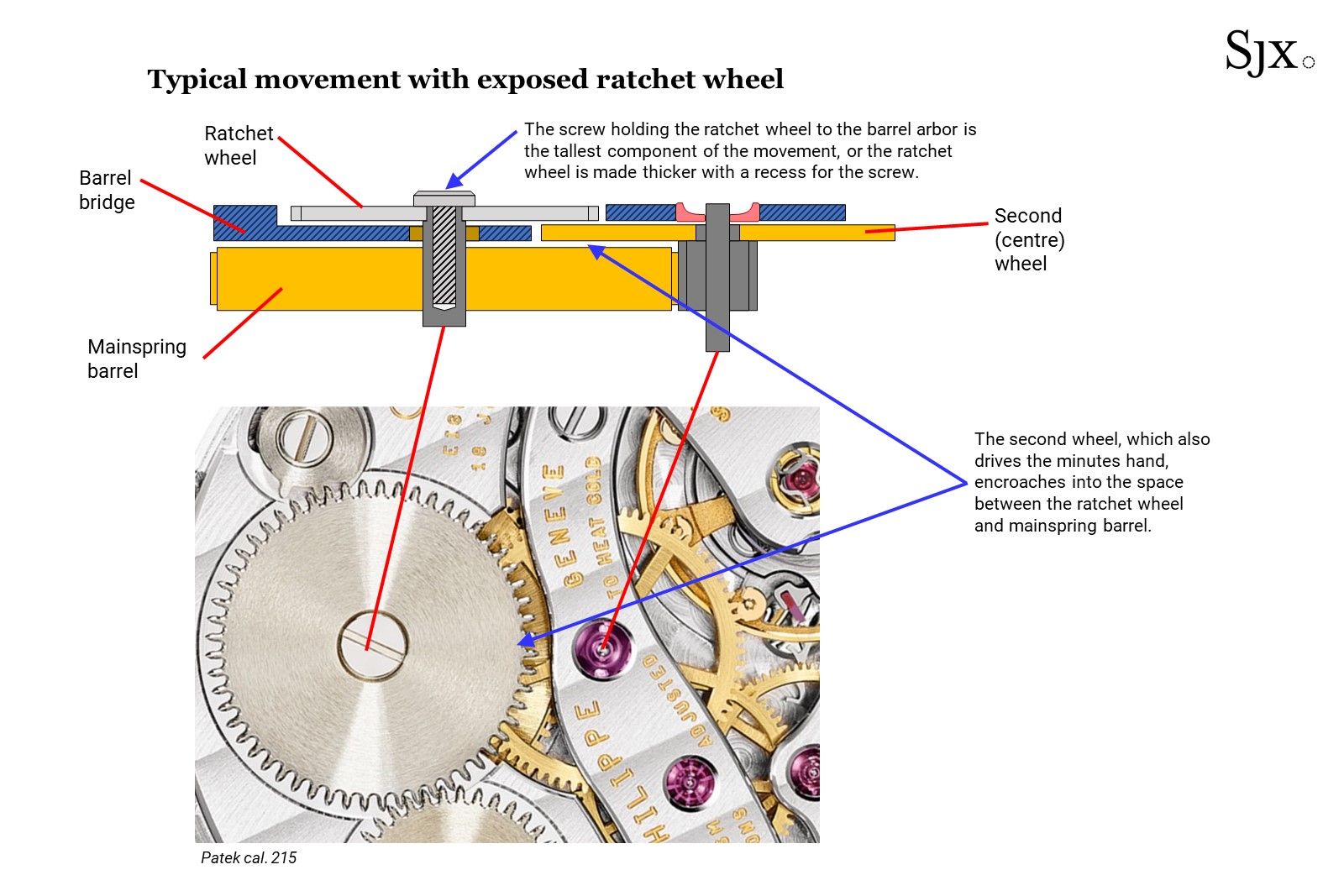
Another solution is to have the ratchet wheel of the barrel located under the barrel bridge, simplifying the bridge design substantially. This is the setup on the cal. 17”’, a decades-old calibre still used by Patek Philippe in its pocket watches.
However, this configuration means the centre wheel often overlaps the ratchet wheel, which takes up vertical space, leading to a thicker movement.
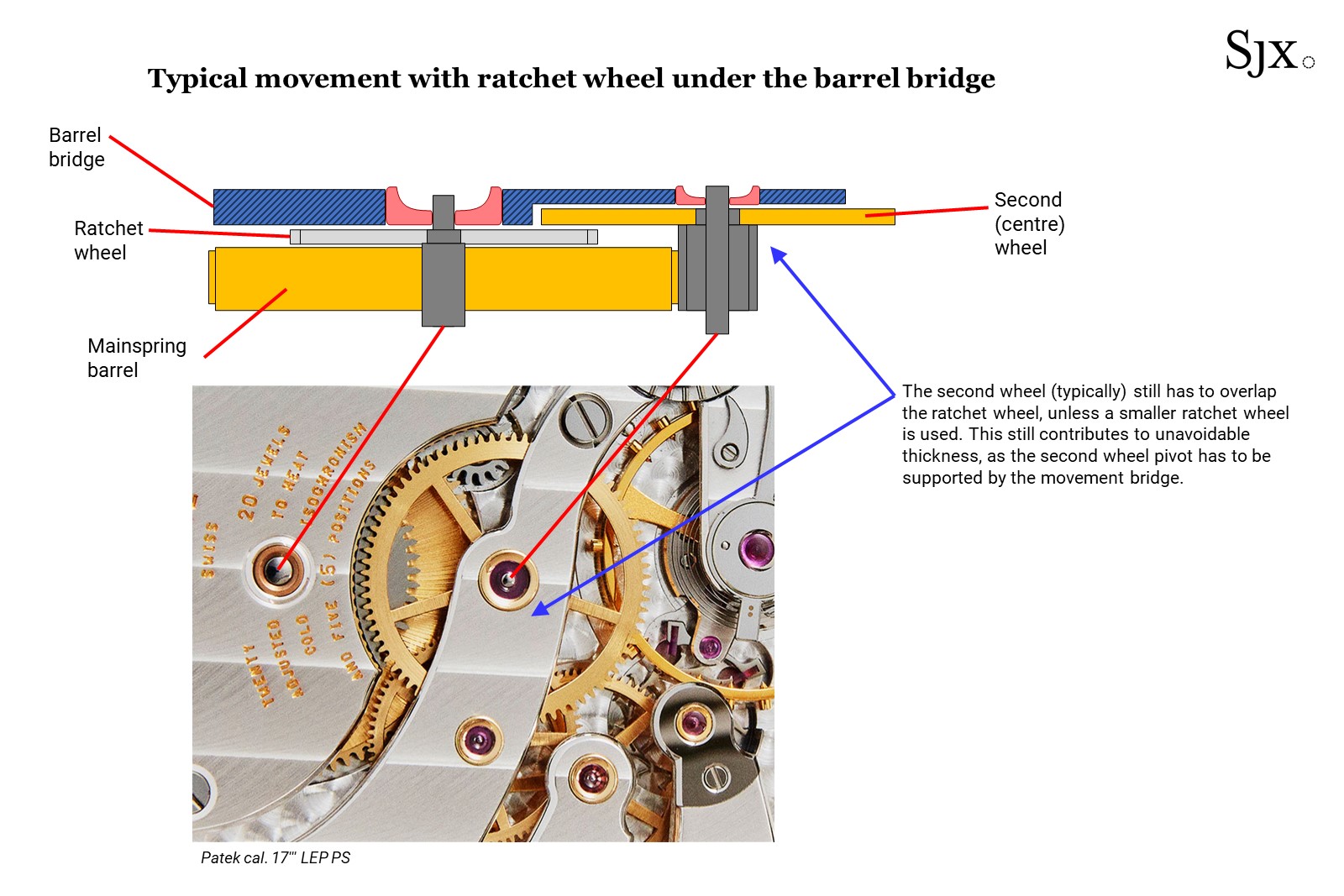
The cal. 30-255 mostly does the latter – it has independent bridges supporting each barrel, which ultimately results in a thinner movement, all else being equal. And it has the ratchet wheels for each barrel hidden under the bridges, which simplifies the bridge design, resulting in a cleaner aesthetic. However, the movement also repositions the centre wheel to preserve its thinness.
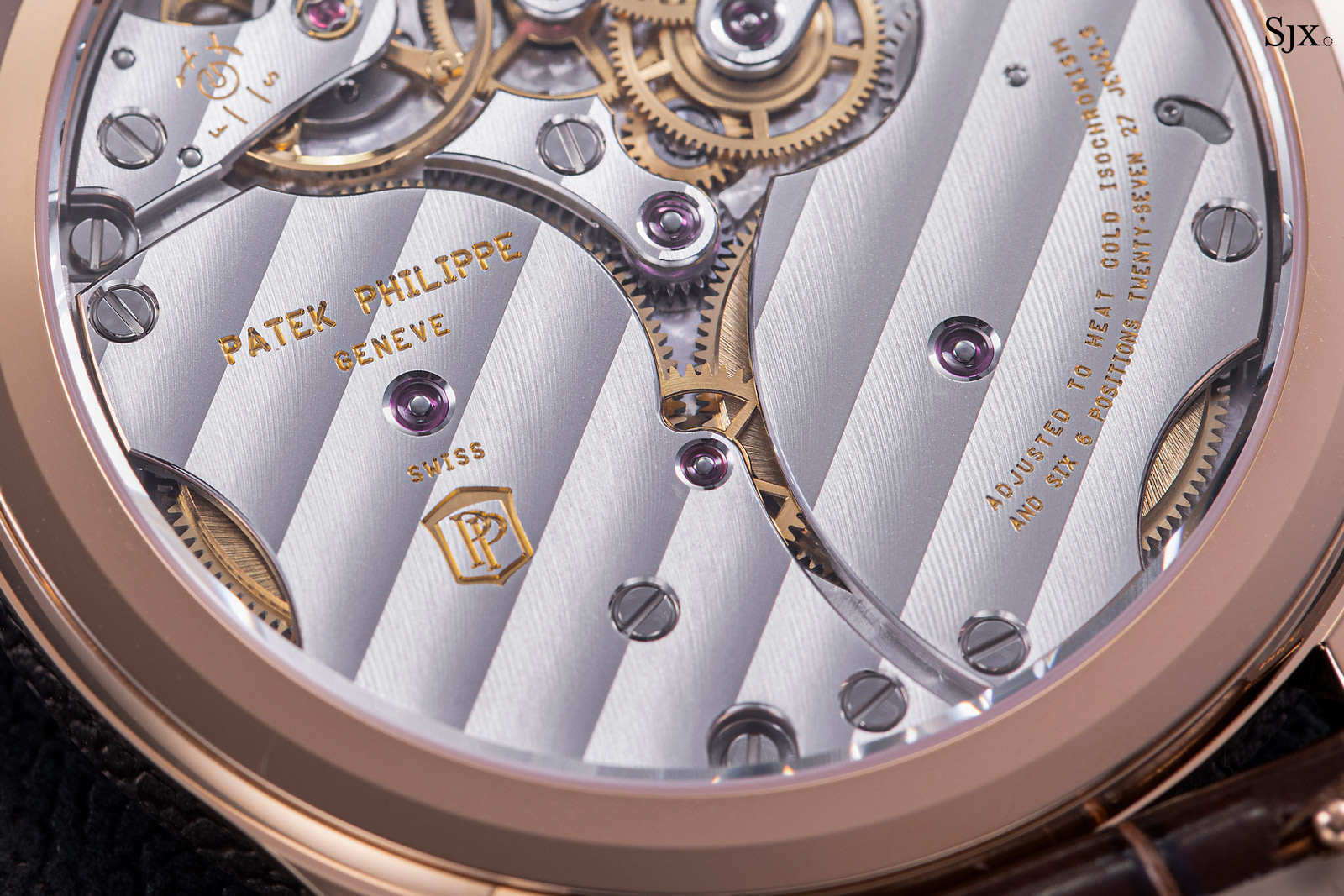
The two large bridges for each barrel, with the left bridge bearing the Patek Philippe Seal
Specifically, the centre wheel is relocated away from the mainspring barrel so that it does not overlap the ratchet wheels. This allows the centre wheel to sit on the same plane as the ratchet wheel, which results in a thinner movement than if the two were on different planes.
Since the centre wheel is now situated further away, this means there needs to be something in between the barrels and centre wheel. The two barrels connect to a centre pinion instead, which rotates one revolution per hour and drives the minute hand.
The centre wheel is relocated via an intermediate wheel that is also driven by the centre pinion. With this intermediate-wheel setup, the movement height can be preserved, since the wheels are spread out on the same plane rather than stacked up on multiple planes. Think of it as a single-storey building with multiple rooms, instead of a multi-storey structure.
Besides spreading out the gear train, the intermediate wheel serves to preserve the direction of rotation – otherwise, the seconds hand on the fourth wheel would rotate in the opposite direction of the minute hand on the centre wheel.
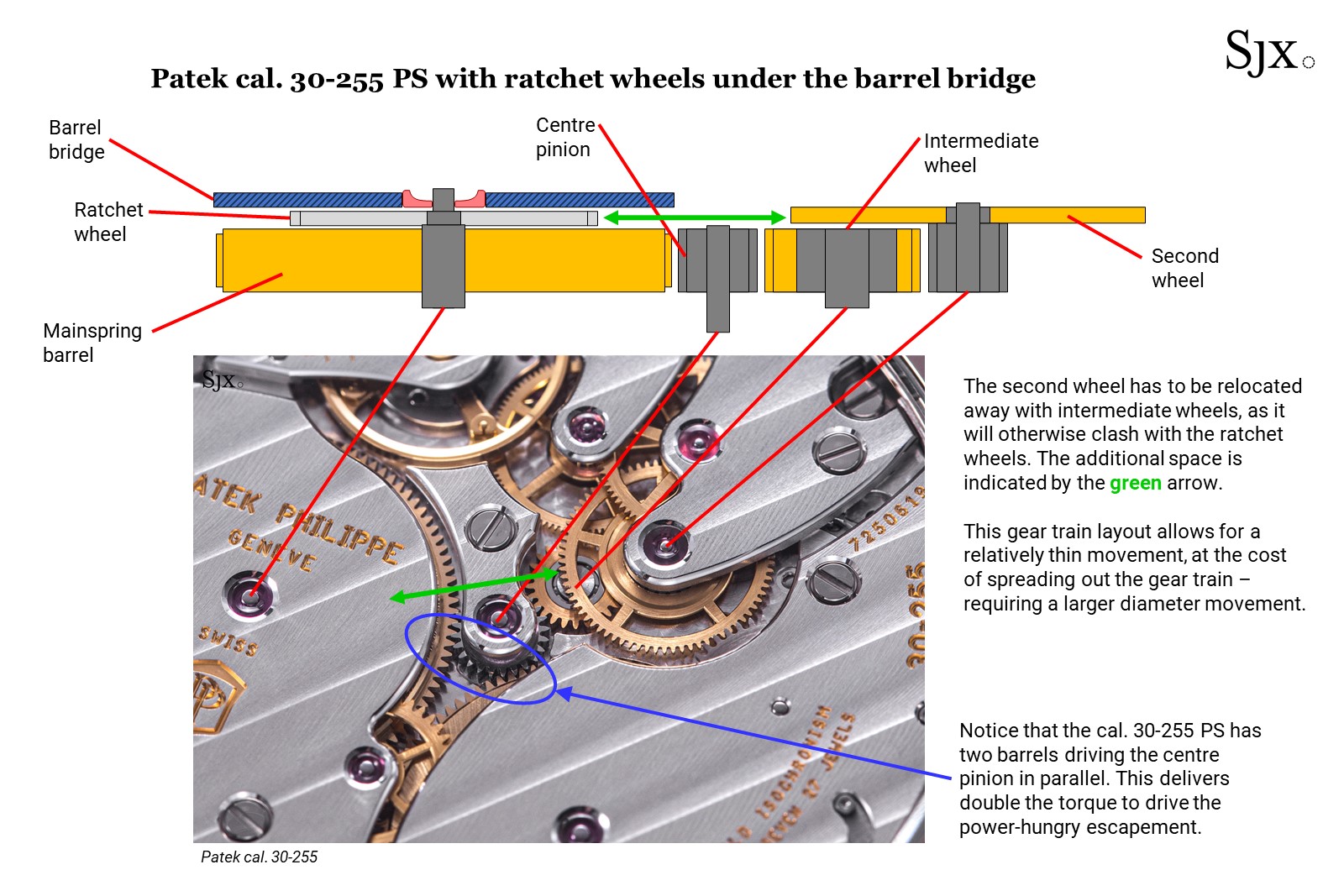
The cal. 30-255 with the gear train spread out to maintain thinness
This approach isn’t new. The spread-out train is also found in the three-handed cal. 4302 inside the Audemars Piguet Code 11.59 for instance. But there it was done to accommodate the central seconds of the Code 11.59, besides thinness. In the cal. 4302 the intermediate wheel allows the gear train to be repositioned to have a central seconds without adding excessive thickness as it is already quite thick, being an automatic movement with a full rotor.
But intermediate wheels are not a perfect solution, since more wheels in the going train increases friction. But it is an acceptable compromise in the case of the cal. 30-255 considering the massive torque generated by both barrels, which can easily overcome friction in the gear train. Increased friction in the slower moving wheels of the gear train is preferable to excess friction between the faster moving wheels like the fourth or escape wheels, which is the case in the cal. 30-255, since the intermediate wheel sits next to the barrels.
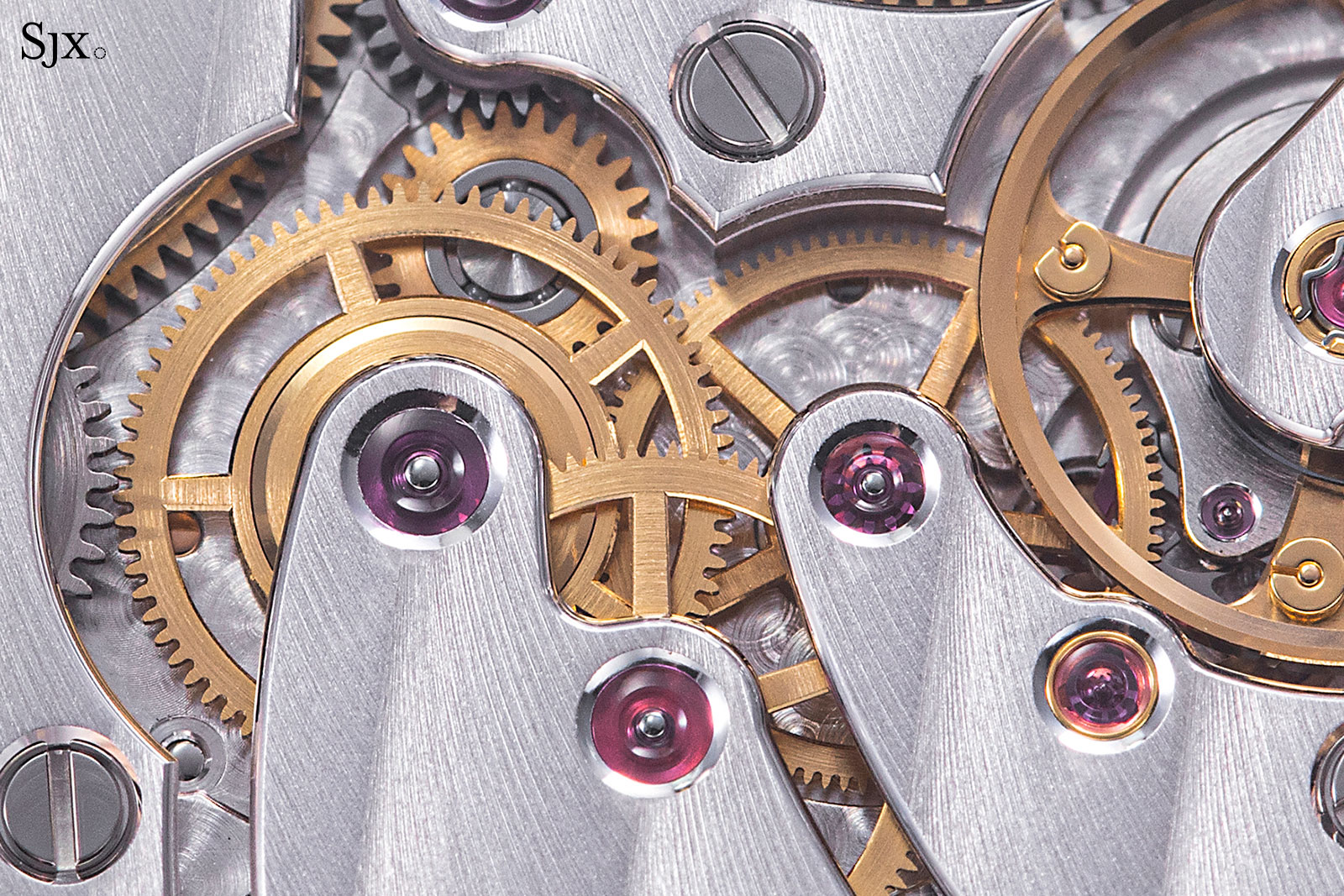
The gear train with the intermediate wheel
With the barrels occupying half of the movement, the other half is used for the going train. The dense construction is entirely positive and contributes to the high HDF, since the available space has been used as efficiently as possible for maximum energy storage.
Notably, the addition of a second barrel results in a relatively small balance cock – it seems disproportionately small compared against the balance – showing just how much has been crammed into the available space.
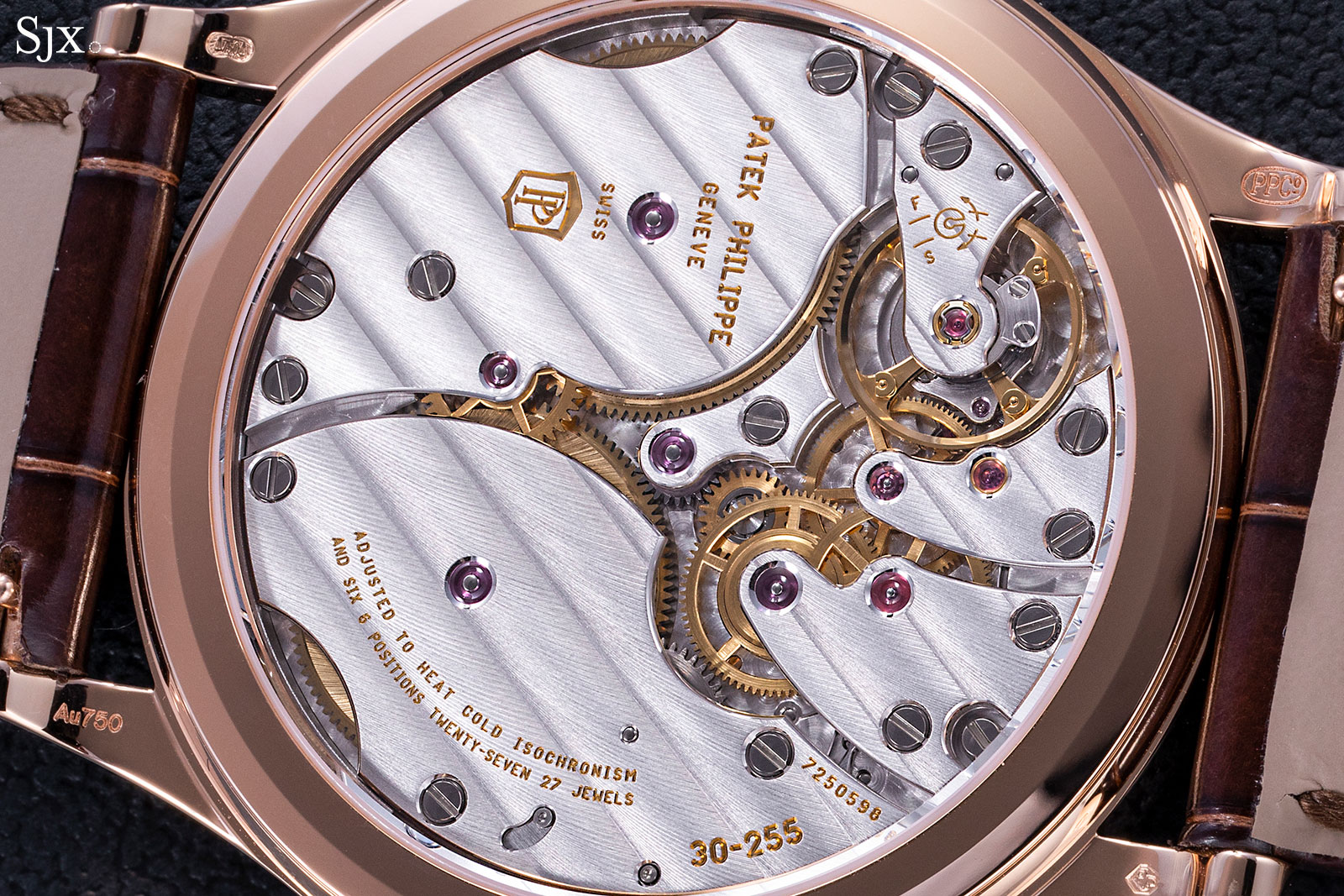
The twin barrels take up most of the left half of the movement, with the gear train and balance on the right
The minimal remaining space in the movement sits right next to the crown, and contains the crown wheel for hand-winding the barrels. Just like the ratchet wheels, the crown wheel is hidden under the barrel, with the only hint being a pin with a polished, domed top that serves as the pivot for the crown wheel.
Also worth mentioning is the remaining space also houses the hacking mechanism. As Patek Philippe movements historically did without a hacking seconds, this runs contrary to tradition but is very much a welcome convenience. The hacking lever mechanism runs along the edge of the going train, an efficient utilisation of space.
In short, the cal. 30-255 is smartly constructed to be as space-efficient as can be. The larger movement isn’t just for filling up the case of a larger watch, but it fully utilises the space for maximum mechanical and chronometric gain.
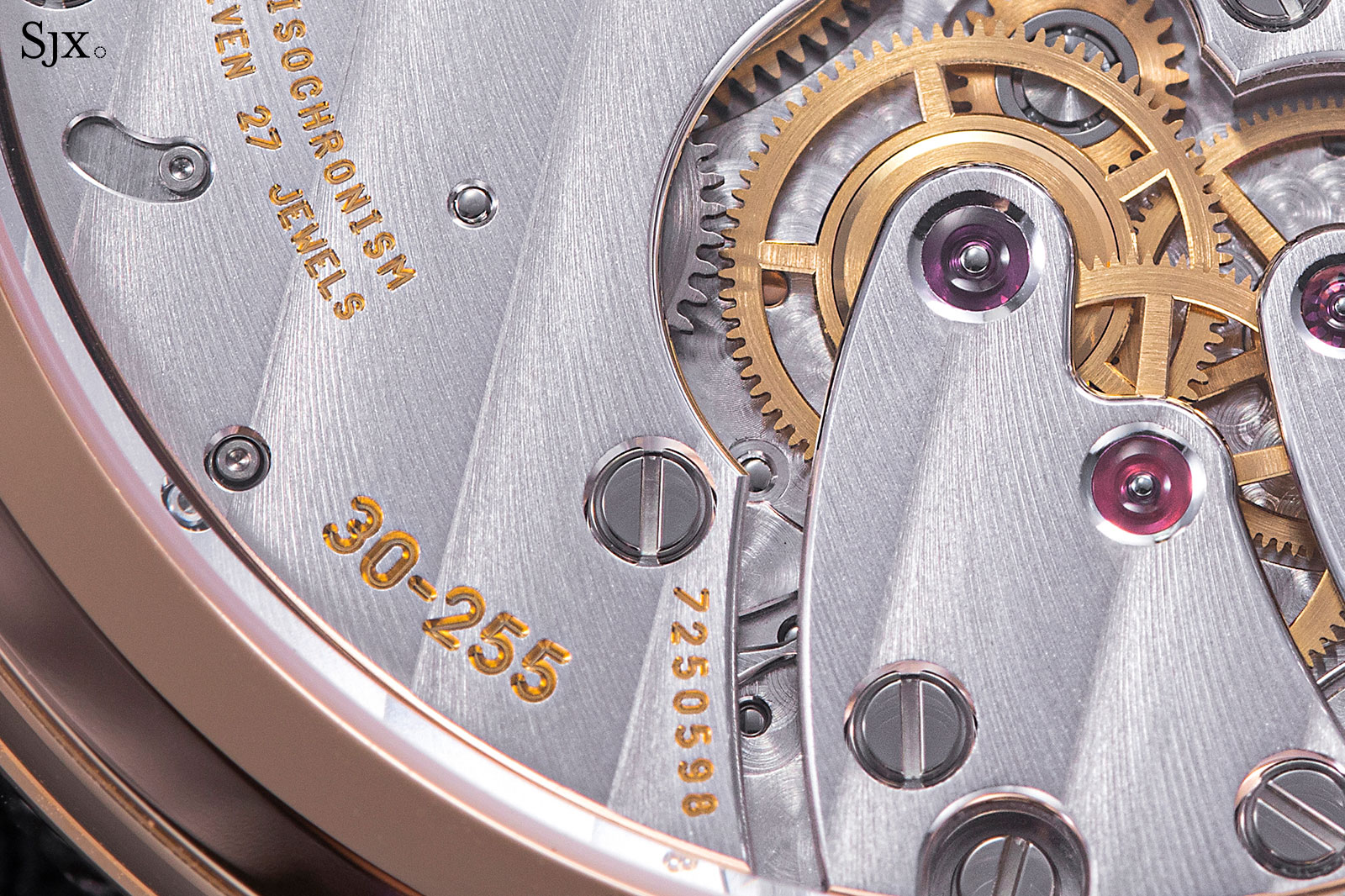
The crown wheel pin is visible to the right of “Isochronism” on the barrel bridge
Finishing
The cal. 30-255 is appealing visually not only for its finishing, but also its design. Unlike most modern-day movements that look mostly, well, modern, the cal. 30-255 evokes vintage calibres with the gracefully shaped bridges. Add to that the finishing and it’s a good looking movement.
The finishing of the cal. 30-255 is as expected from Patek Philippe at this level – it’s an expensive watch but entry level for the brand – which is neatly done with all the expected flourishes. However, there is an inevitable comparison with its predecessors – how does the new calibre compare with the cal. 324 and 215?
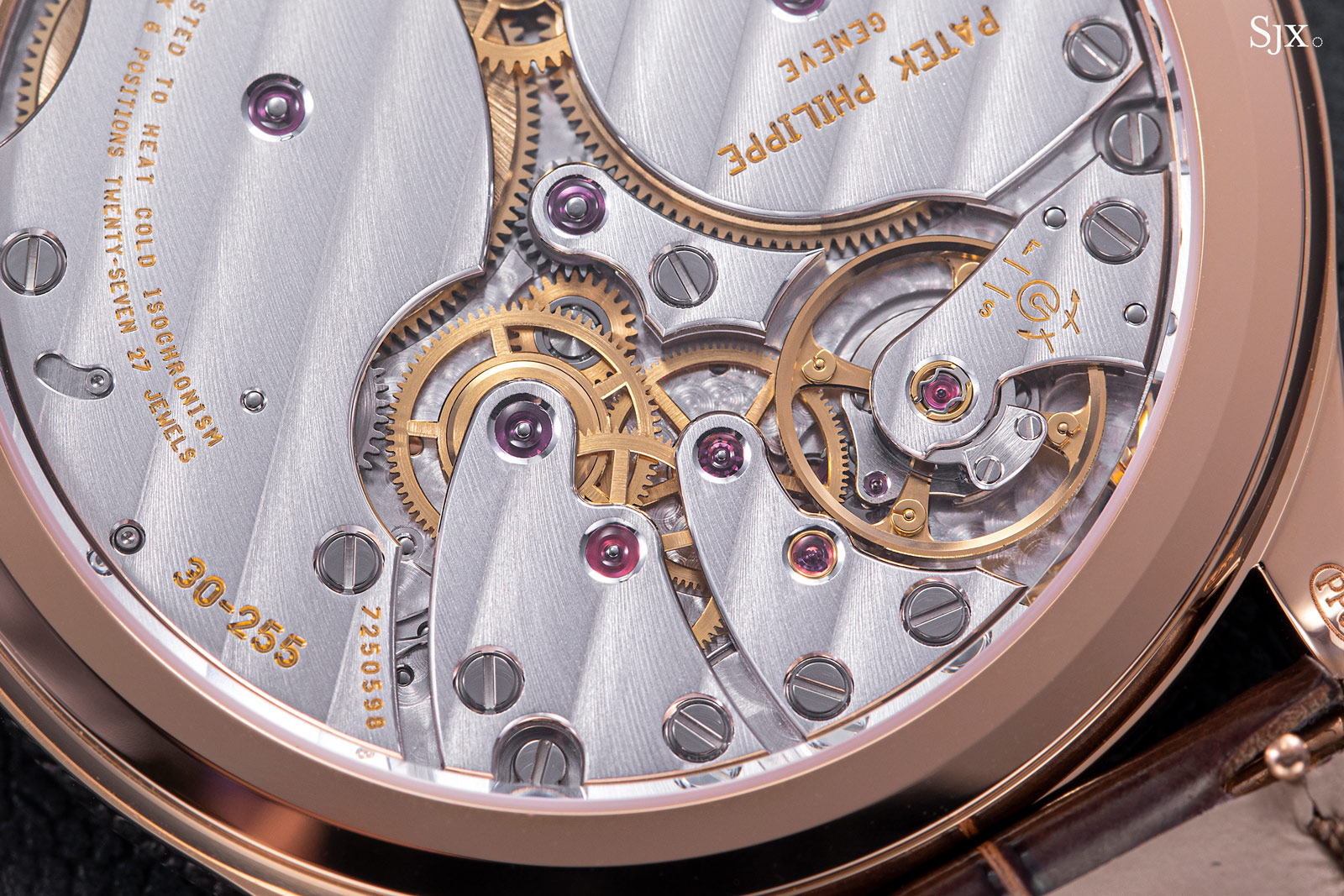
An especially appealing design feature are the twin bridges for the going train (at bottom), instead of a single, large bridge that would have been easier but less appealing
While at a glance the movements seem finished to similar levels, the cal. 30-255 has one major advantage – bridge architecture. Having neither a rotor nor large ratchet wheels, the multiple bridges of the cal. 30-255 take prominence, especially since they all sit on the same plane.
The bridges are elegantly shaped with graceful curves, while still leaving just enough of the important elements exposed, making for a pleasing design that completes the case back view.
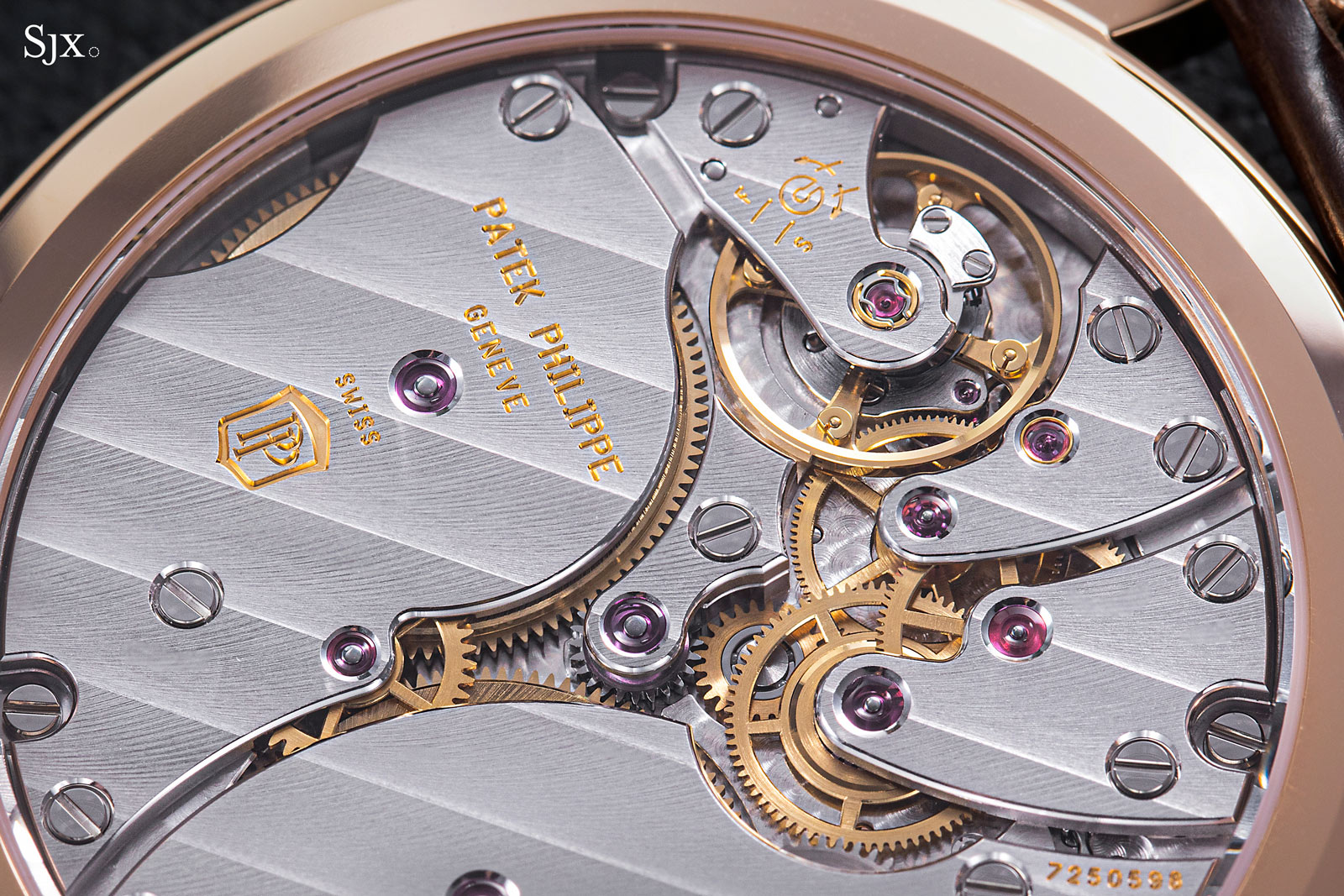
The long, curved edge of the barrel bridges have neatly uniform, rounded anglage throughout their entire length
One might argue however, that the smaller movement of the cal. 215 requires more careful and intricate anglage, or bevelling, thanks to the smaller bridges.
But the cal. 30-255’s larger movement and bridge size allows for easier appreciation on the eyes, even without a loupe. The multitude of bridges means that there are plenty of curved edges, which serves as a large canvas for anglage.
Unlike the shallow, flat bevelling found on some past movements, the bevelling on the cal. 30-255 is of a finer sort, having a polished and rounded surface. That said, the bevels do betray the faintest machining marks at magnification, indicating they were done by machine before being given a once over with a handheld tool to create the mirrored finish.
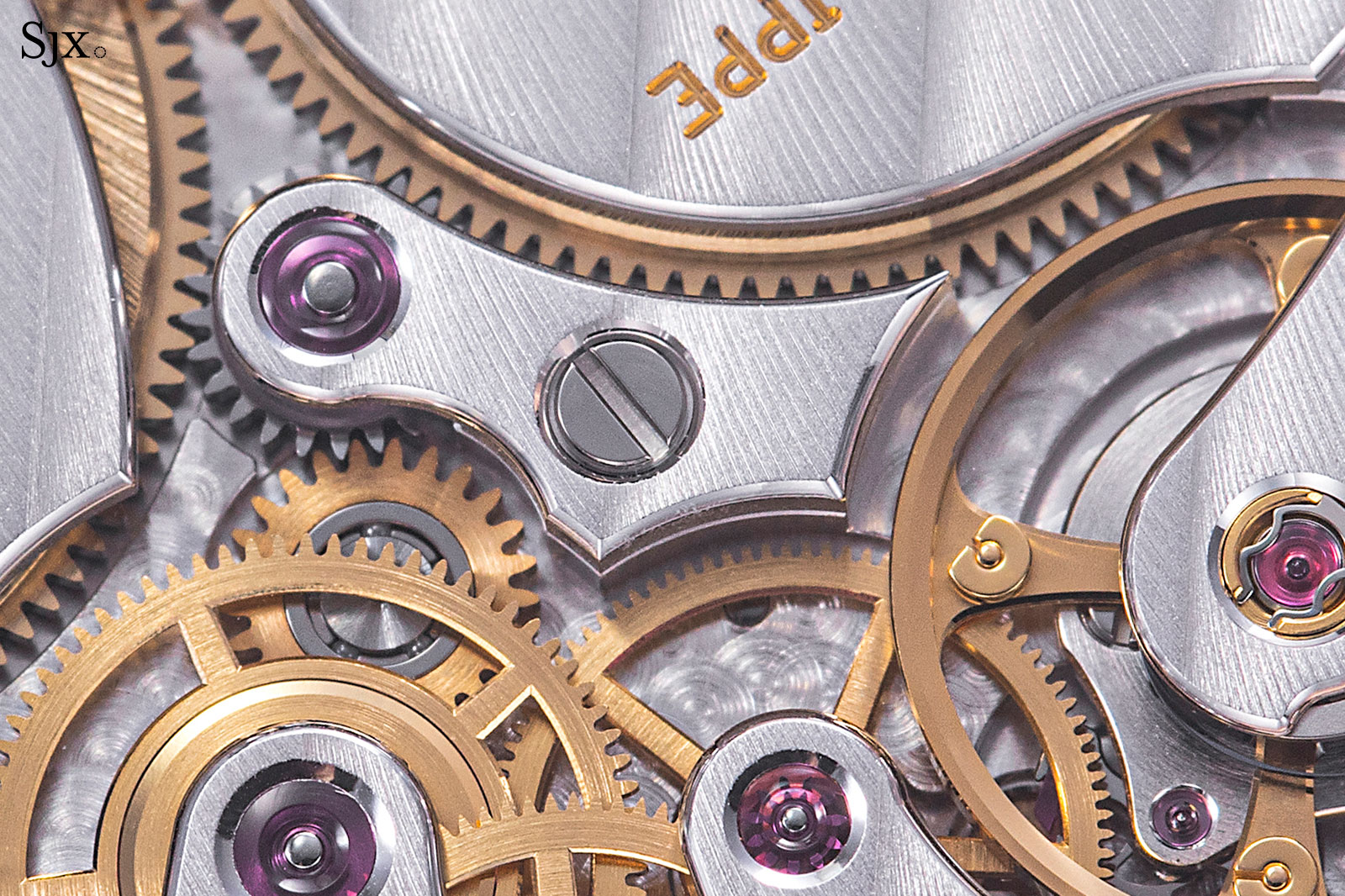
Notice the four outward angles on the small bridge holding the centre wheel that drives the minute hand
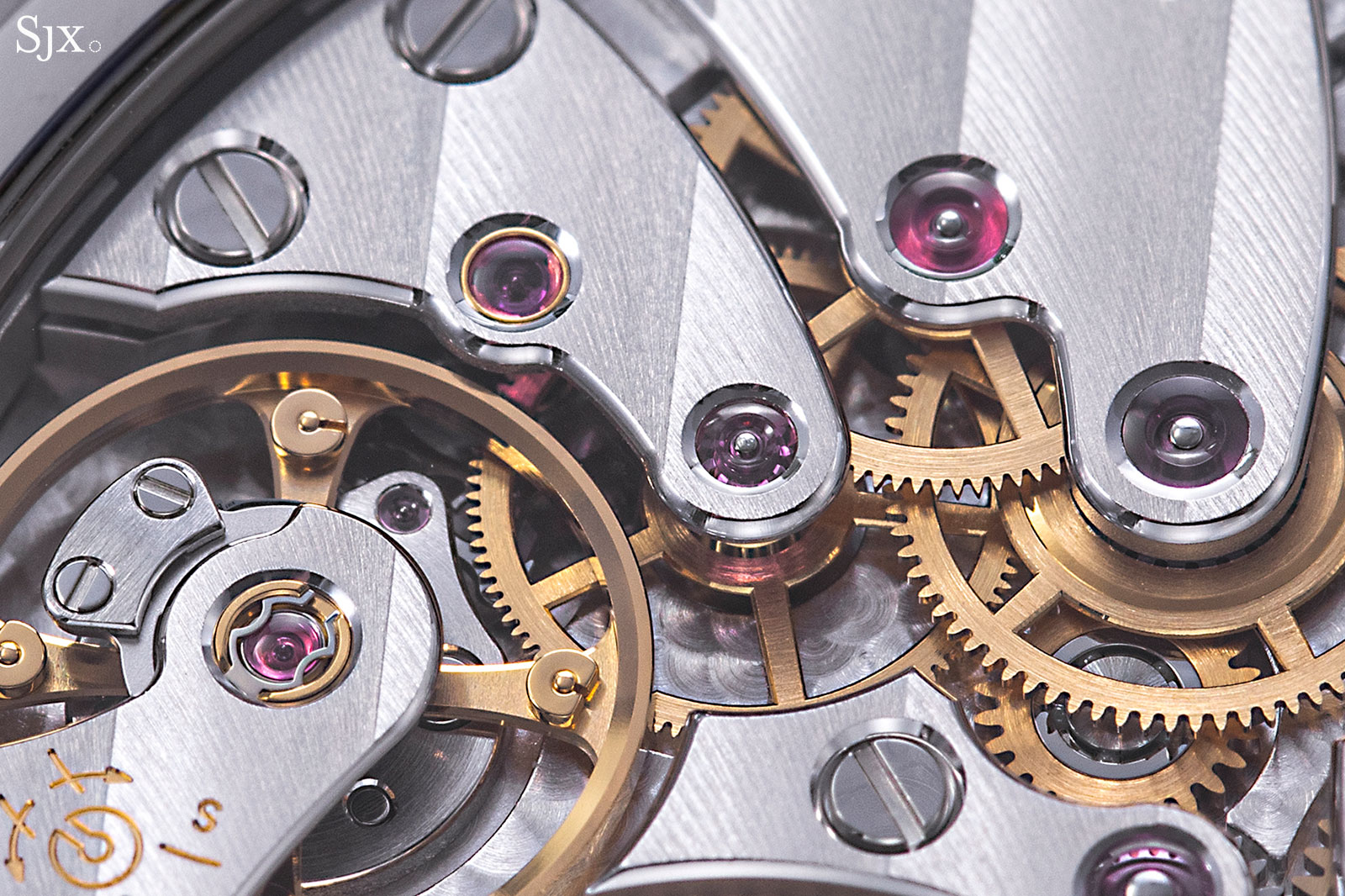
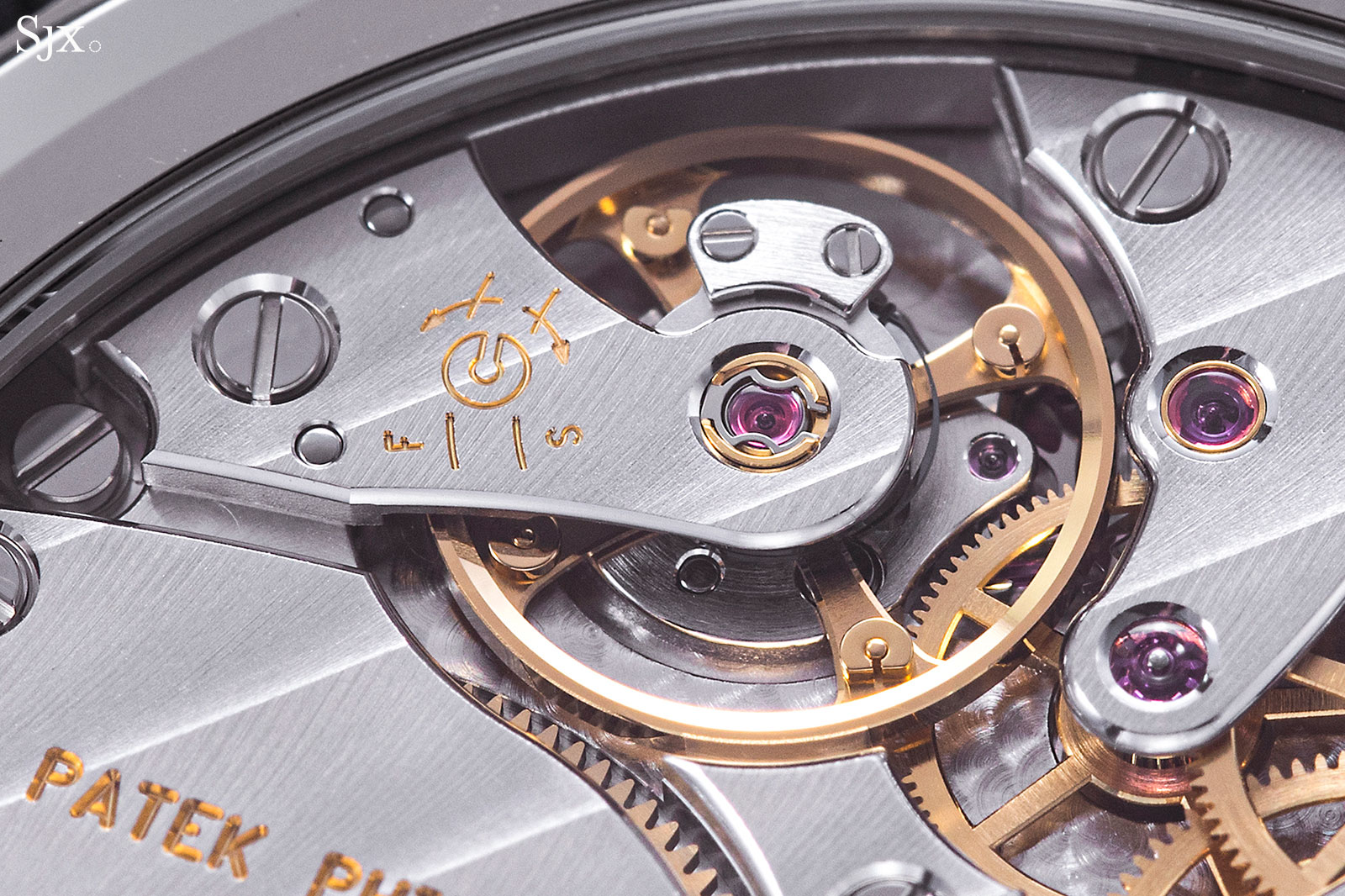
However, there are no inner angles anywhere – all inward corners are instead rounded off, which is unfortunate but is an unspoken norm in today’s watchmaking environment.
The addition of even just a couple of inner angles would have significantly increased the appeal of the finishing to enthusiasts, especially given the large bridges to work with.
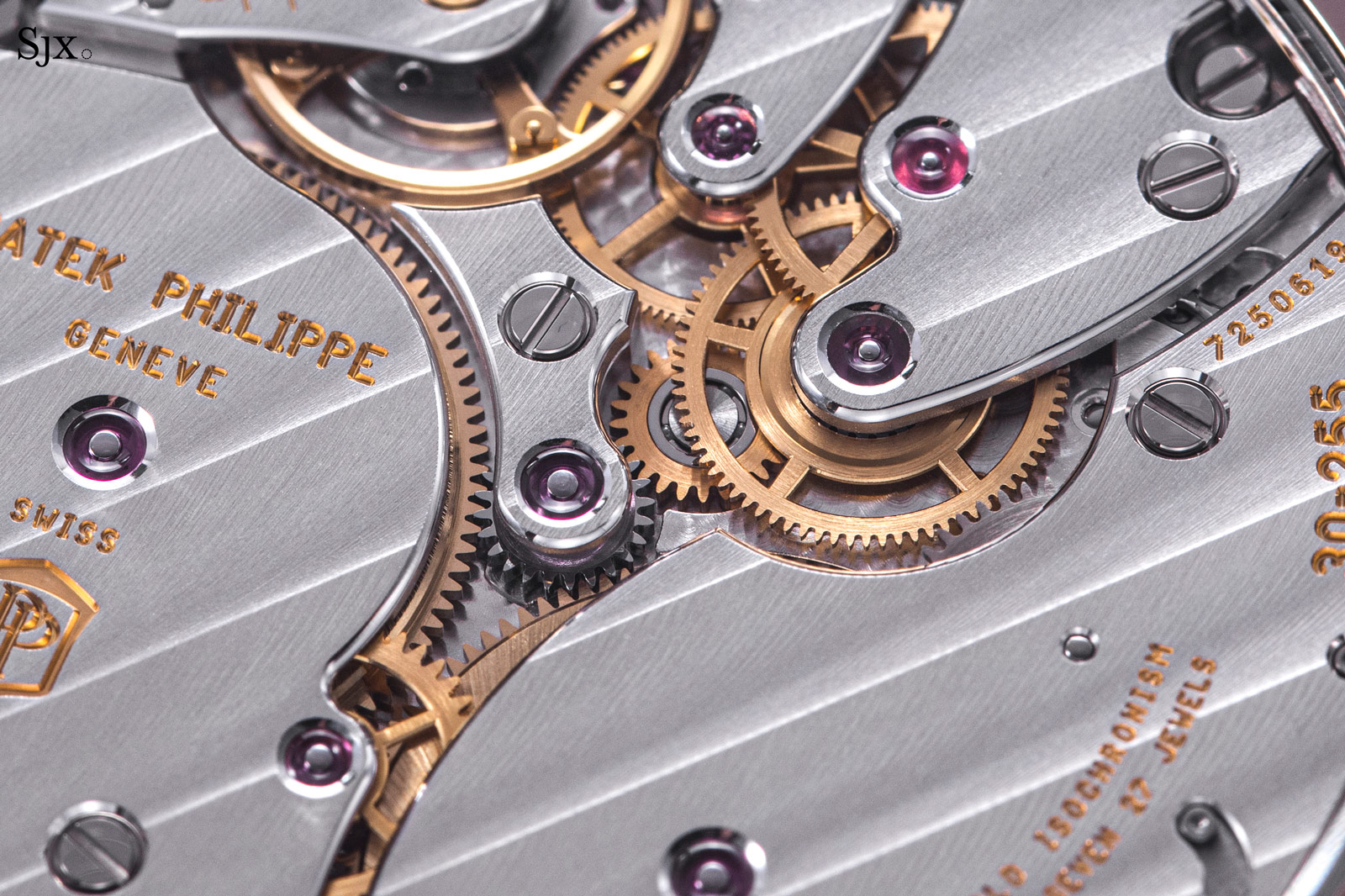
The Côtes de Genève are relatively wide for a Patek Philippe movement, though entirely proportional to the large diameter. The width of the stripes further emphasises the size of the movement, especially when set against the cal. 215 for instance.
As on other Patek Philippe movements, the stripes themselves have a fine, curved granularity with sharp boundaries between them. The only nitpick here is that the striping is occasionally applied too heavily, resulting in a slightly uneven surface, which is more obvious at the border where the anglage meets the stripes.
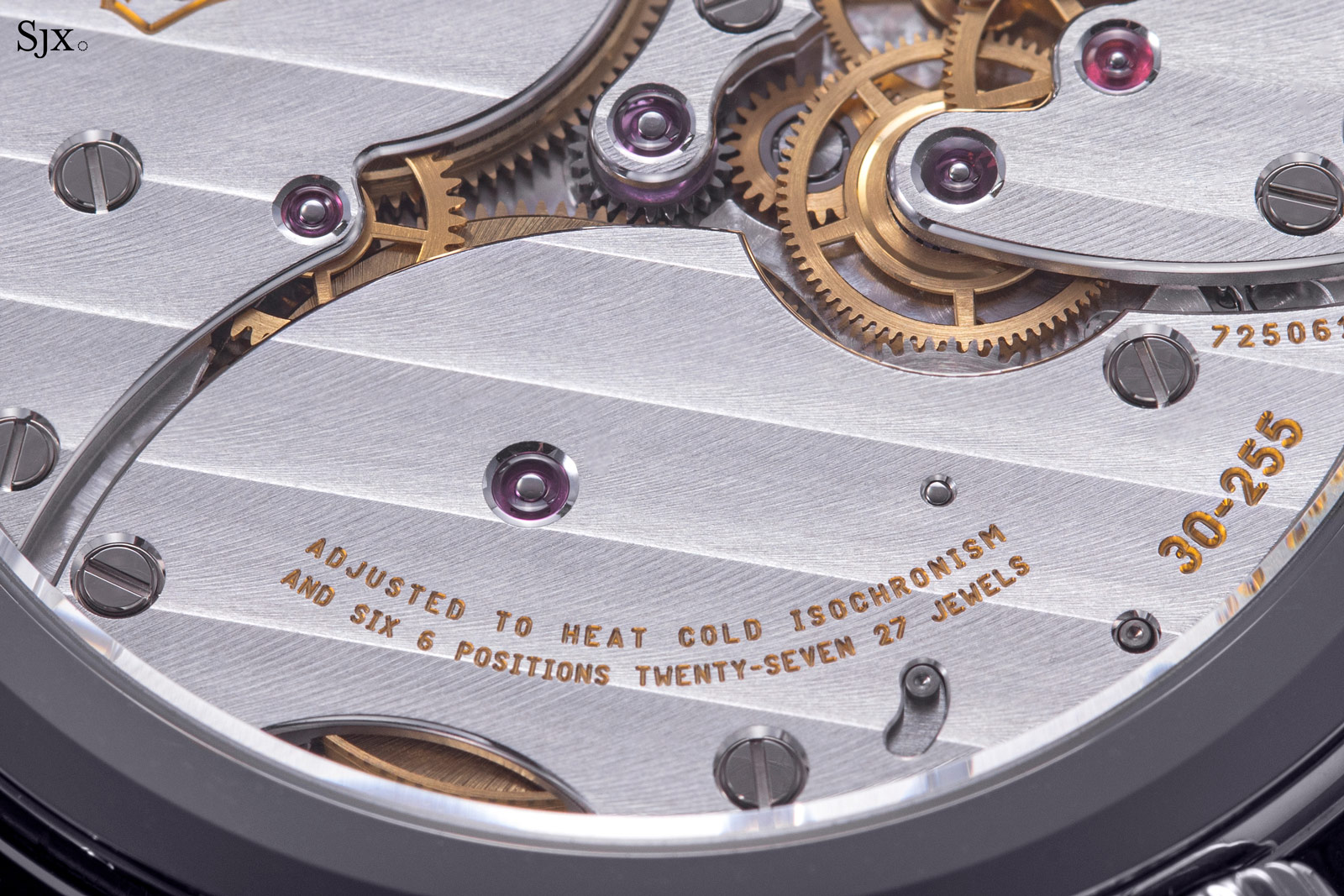
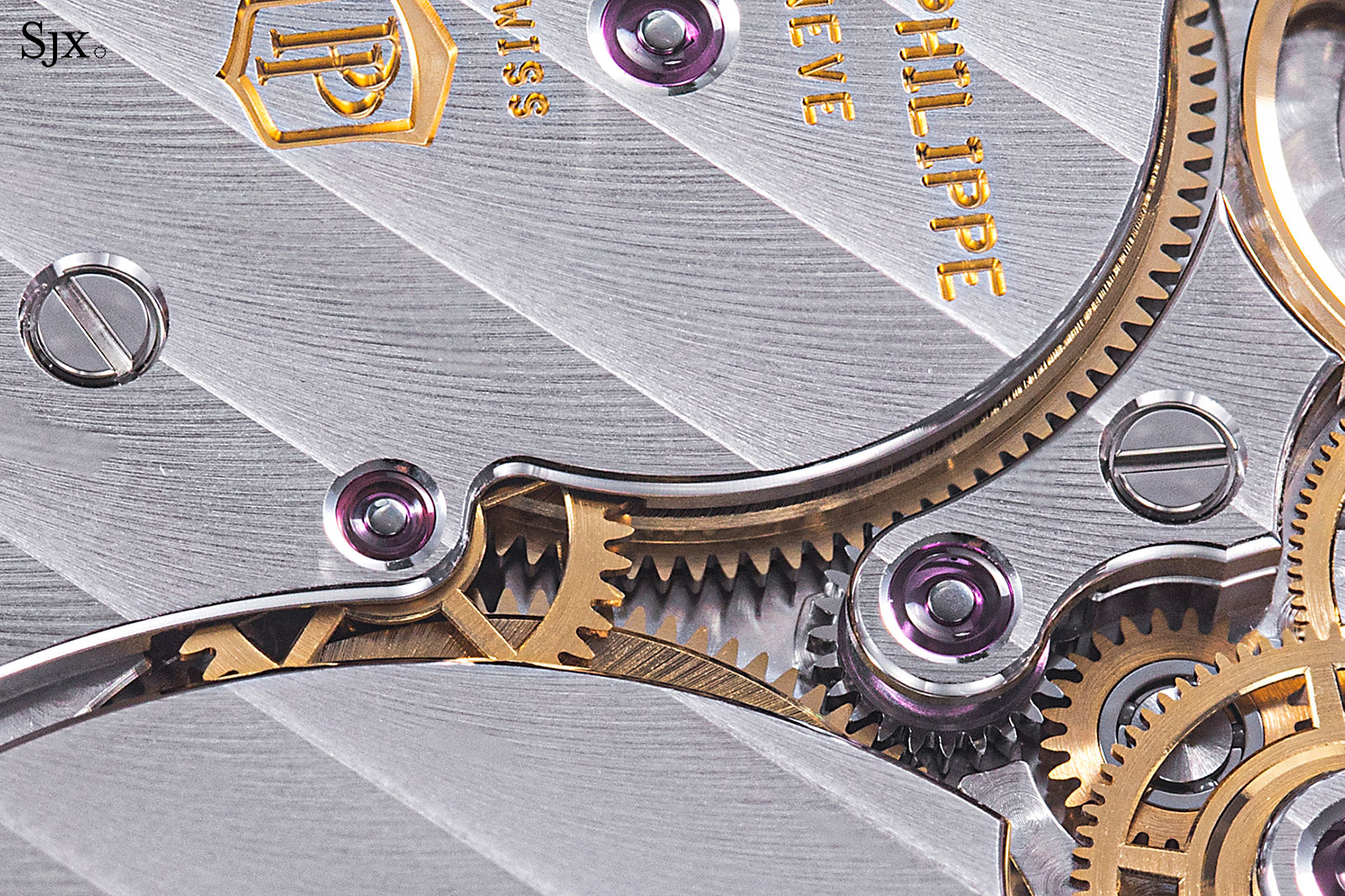
Notice the edge where the stripes meet the bevel on the barrel bridge
The rest of the finishing is typical Patek Philippe – so it is excellent and thorough.
There are polished countersinks for the screw and jewel holes, black-polished screw heads, polished and domed steady-pins, as well as large ruby bearings that all contribute to the jewel-like, sparkling appearance that is expected from a movement in this price.
Though hidden on the watch, photos of disassembled movements reveal that Patek Philippe ensures the careful finishing extends to the unseen components under the dial, such as the keyless works.
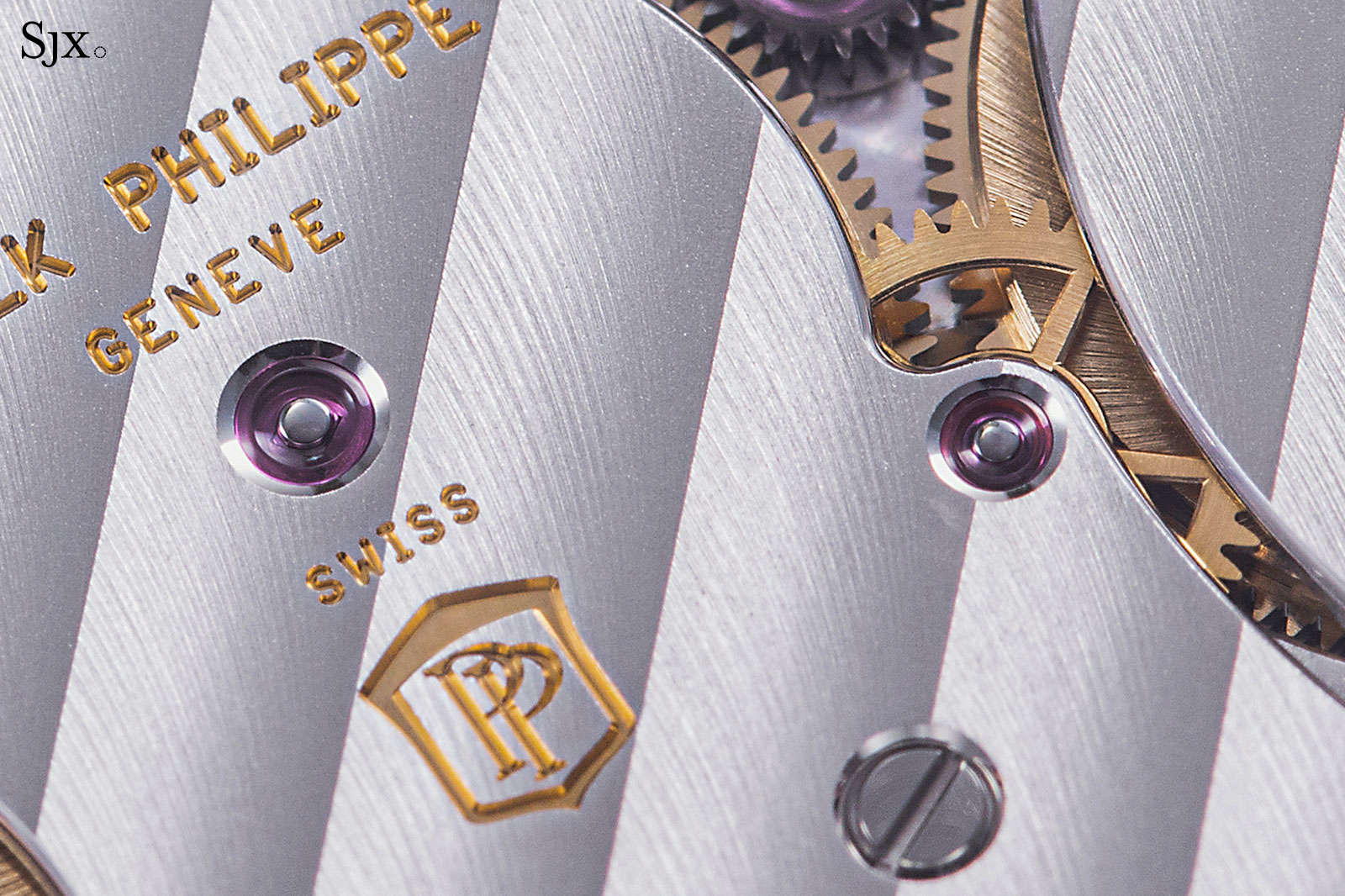
Polished countersinks and even chambered spokes on the wheels
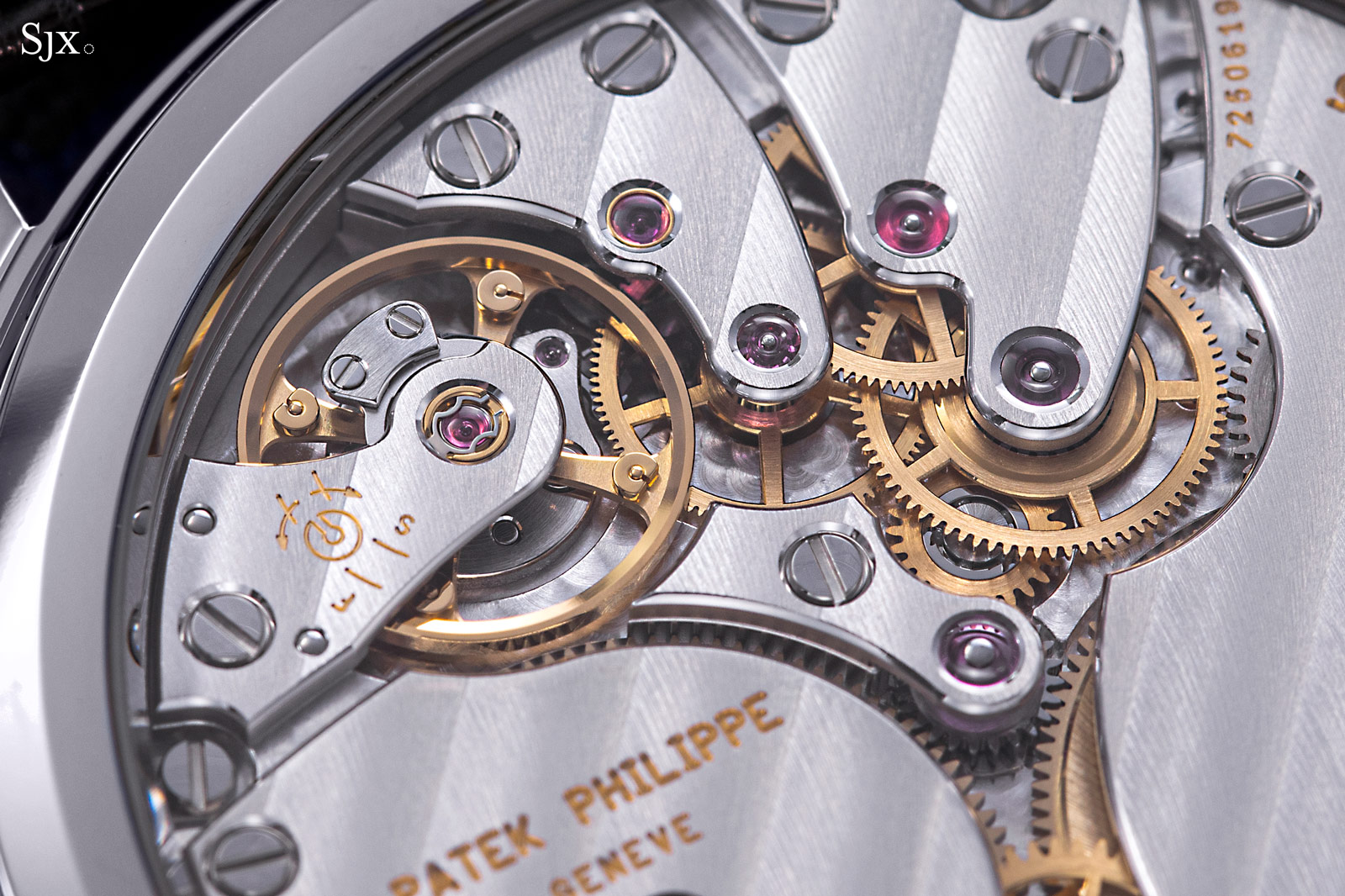
Concluding thoughts
In its entirety, the ref. 6119 demonstrates the vast progress Patek Philippe has made in its entry-level models. The ref. 6119 scores highly in terms of execution – both the styling and quality are done well. In particular, the dial is surprisingly fancy for a simple design, while the movement has a smart, sophisticated construction.
The watch is priced at a premium compared to the competition, but the movement is brand new and technically superior – and it is a Patek Philippe.
Key facts and price
Patek Philippe Calatrava “Clous de Paris”
Ref. 6119G-001 (white gold)
Ref. 6119R-001 (rose gold)
Diameter: 39 mm
Height: 8.08 mm
Material: 18k white or rose gold
Crystal: Sapphire
Water resistance: 30 m
Movement: Cal. 30-255 PS
Functions: Hours, minutes, and seconds
Frequency: 28,800 beats per hour (4 Hz)
Winding: Hand wind
Power reserve: 65 hours
Strap: Alligator with gold pin buckle
Availability: Now at retailers
Price: US$29,570; or 39,000 Singapore dollars
For more, visit Patek.com.
Back to top.

